Welcome to our comprehensive and informative buyer’s guide for gun safes in 2024!
Whether you have a decent-sized collection of firearms or just a few stashed away in a closet or drawer, you really shouldn’t put off finding a safe and secure place to store them.
You risk losing your precious collection of guns to theft or fire if you’re on the fence about it for too long.
Having more than one gun safe in your home for different scenarios is tactically sage advice, and is a big part of our multi-layered defense and gun storage philosophy.
We’ll be imparting many of our core tenets on gun safe ownership with various tactical and practical use cases throughout this article.
The main goal of this article is to answer all of the most common questions people often ask regarding the topic of gun safes.
By tackling each of these important questions one by one, we hope to demystify and shed some light on the perplexing variety of gun safe choices out there.
We’ll also show you the different types of gun safes and what category they fall into, as well as some of their key features and use cases.
The Complete Gun Safe Buyer’s Guide 2024 Edition
When considering a gun safe, the most critical decisions shouldn’t be hampered by a lack of knowledge which will lead you to making the wrong purchase for your specific needs.
We aim to arm you with the best information possible so that you can feel confident in knowing exactly what to look for in a gun safe that will meet or exceed your tactical expectations and gun storage needs.
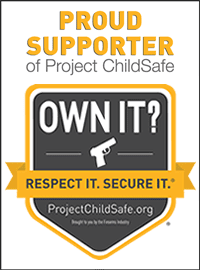

Why is Gun Storage Important?
There are many reasons why gun storage is important. One reason is that it keeps guns out of the hands of children.
According to the website safekids.org, “Every day in America, seven children under the age of 18 die from firearms injuries—three are suicides, four are homicides.”
Another reason to store guns safely is that it makes them less likely to be stolen.
A study by the Bureau of Justice Statistics found that; “State and local law enforcement agencies reported 211,000 firearms stolen during burglaries and other property crimes in 1992. This figure represents 42 percent of all firearms reported stolen that year.”
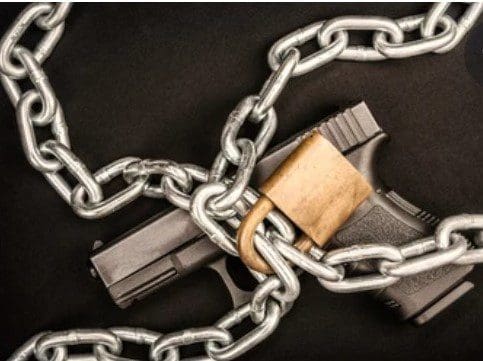

A third reason to store guns safely is that it keeps them from being used accidentally. Every year, there are thousands of accidental shootings that could have been prevented if steps were taken to securely store firearms in the home.
All of the above cover the most obvious reasons but, beyond that, there are also tactical reasons to store guns in a few key strategic locations in your house.
If you want to prevent unauthorized access to your firearms while also improving your ability to defend those you love in a dire situation, then finding the right locations to store your guns safely is a must.
You may decide to share these locations with a spouse or those you trust should you be away when a break-in occurs.
Depending on where you live, there may even be legal requirements to keep your firearms secured in a gun safe.
Even if no such laws apply to you, it’s still a good idea to buy as many gun safes with as much storage as you need to protect your family, your investments, and your property.
If you have a substantial amount of money invested into your gun collection, you owe it to yourself to invest in a safe storage solution.
Some theft and fire insurance policies may require that your guns be put in a safe if you want them to be covered in the event of an unforeseen loss.
A quality gun safe is an investment that will pay for itself should the worst come to pass.
For this reason, always buy the highest quality gun safe that you can afford to buy. You want your safe to be as strong and reliable as the firearms you purchased to defend your life.
As a general rule of thumb, a quality-built gun safe will be worth between 15-25% of your entire gun collection.
What is the Best Gun Safe to Purchase?
There are many different types of gun safes on the market, so it can be difficult and confusing to decide which one is right for your needs.
Not to worry!
By the time you’re finished with this article, you’ll be well on your way to finding the perfect gun safe for your specific needs.


Here are a few things to consider when looking to purchase the best gun safe for your needs:
- The size of the safe is important: You will need to make sure that the safe can fit all of your current firearms and have space enough left over for future gun purchases- as well as any ammunition or accessories you want securely stowed away. If you want to decentralize your firearm collection, consider looking at buying multiple smaller safes instead of one large safe.
- The type of lock on the safe is also important: Make sure that the safe has a lock that you can trust and that is difficult to break into. There are a few types of locking mechanisms to choose from that we’ll cover in detail later on. (Most gun safes have a backup key in case those methods fail.)
- The cost of the safe is also something to consider: Make sure that you find a safe that fits within your budget but you should be very wary of the cheaper options. A good safe is an investment that should be proportionate to the size and cost of your gun collection. If you have a vast and/or expensive gun collection, you should consider spending more on a higher-quality gun safe to protect those assets or any irreplaceable family heirlooms.
Here are a few additional things to keep in mind when shopping for a gun safe:
- Size: Make sure the safe is large enough to hold all of your guns and any other valuables you want to store. Measure the length, width, and height of your guns to ensure they will fit comfortably inside the safe.
- Security: Consider the level of security you need. A gun safe with a thick, solid steel body and a reliable lock system is generally more secure than a cheaper model with a thinner body and a less reliable lock.
- Fire protection: If you live in an area prone to fires, you may want to consider a gun safe that is rated to withstand high temperatures.
- Ease of use: Consider how easy the safe is to open and close. A safe with a keypad or biometric lock may be more convenient than one with a traditional key lock.
Ultimately, the best gun safe for you will depend on your individual needs and preferences. It’s a good idea to do some research and read reviews before making a purchase.
Gun Safe Categories
If the length of this article isn’t indication enough, let me just tell you straight away that there are quite a few different types of gun safes out there that fulfill specific roles in their respective categories.
Each type of gun safe listed here is designed to perform well within the category it has been assigned to.
These categories have specific use cases in mind and there are some limitations inherent to each type of gun safe- as you will soon find out!
This section will help you differentiate each type of gun safe before you go shopping for one in haste.
Below, we break down each category of gun safe- and a few subcategories- to give you a better idea of what’s available, how they differ, and which one might best serve you.
Portable Handgun Safes:
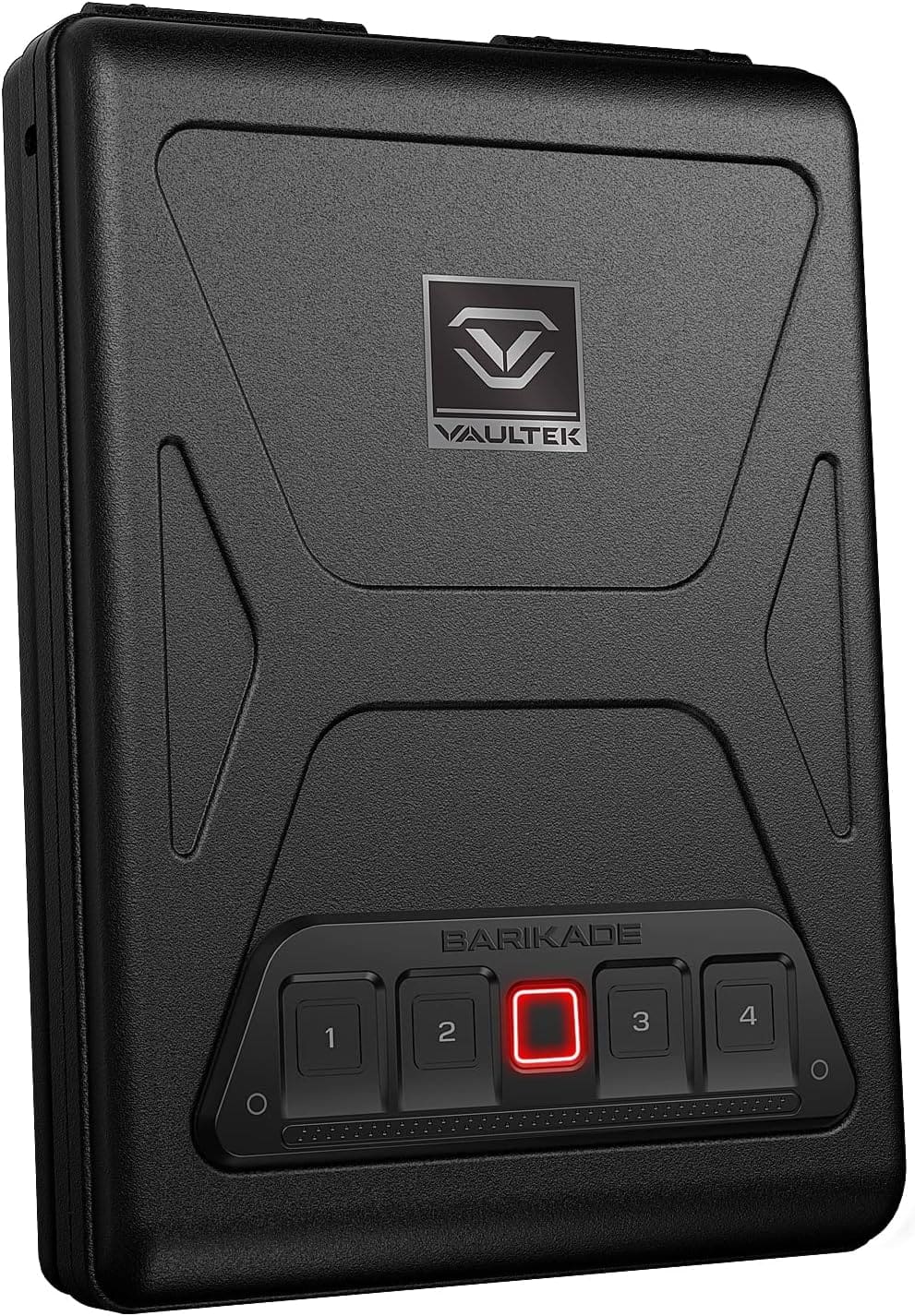

Portable handgun safes are generally lightweight, easy to carry or move around, and can be hidden in your home or car.
Most are not designed to be bolted down but there may be some exceptions out there.
They typically secure your pistol with a keyed lock- as a backup- but may also utilize analog push buttons, a biometric fingerprint scanner, an RFID chip, or an electronic keypad.
Older designs can still be found using combination locks- but these are much less popular compared to modern options that allow quicker access.
1
The Good
- Affordable
- Lightweight
- Portable
- Easily Hidden
- Quick Access
- Reasonably Secure & Childproof
2
The Bad
- Thin Gauge Metal
- Much Easier To Break Into With Basic Tools or Lock Picks
- Easy To Steal If Found
- Most Are Not Air Tight Waterproof or Fire-resistant
3
Pro Tip
We recommend finding a highly-rated biometric option with a backup key if the batteries fail. Analog push-button access may be better for those who don’t want to worry about electronic lock failures.
Portable gun safes are the most affordable options to buy due to their smaller size and weight but don’t provide much in terms of theft, fire protection, or waterproofing.
The main purpose of these pistol safes is to keep the firearm inside secure and safe from unauthorized users that you know and love.
Small Handgun Safes:
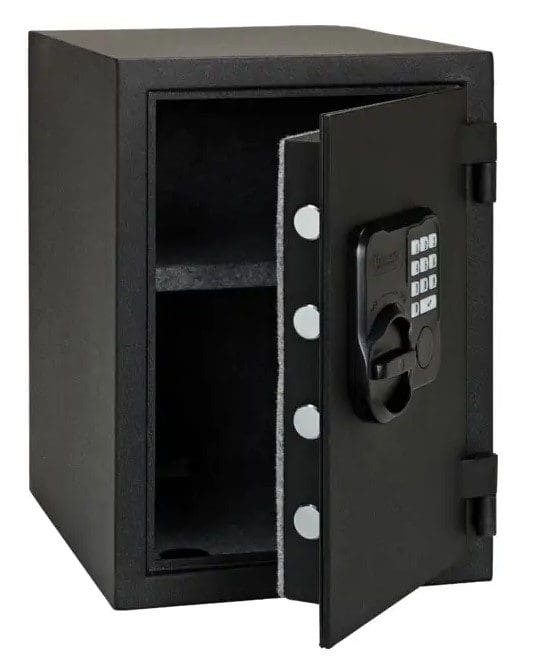

Small handgun safes are larger than portable gun safes but are still small in size and don’t offer much in terms of storage space.
Being a step up in cost over portable gun safes, they use a thicker gauge of steel on the door and thicker sheet metal for the side walls.
Some manufacturers of small handgun safes make fireproof models that are airtight making them waterproof as well.
1
The Good
- Thicker Gauge Steel
- Fireproof & Waterproof Models Available
- Lots of More Affordable Options
- Can Be Bolted Down
- Stronger Locking Mechanisms
- Quick Access Models Available
- Can Store A Wide Range of Assets Including Pistols
- More Secure Than Portable Gun Safes
2
The Bad
- Not All Are Created Equal
- Features Scale With Price
- Not All Are Fireproof or Airtight
- High-End Models Can Get Very Heavy
- Cheaper Models Are Not As Secure & Lack Other Useful Features
3
Pro Tip
It’s worth ponying up for the fireproof/waterproof options that can also store other valuables along with your handguns.
These safes are often marketed as a means to protect valuables like cash, precious metals, jewels, and documents but can also store handguns.
Most small gun safes are meant to be bolted down to prevent them from being removed by thieves and can be more easily hidden than the larger safes below.
Mid-Sized Multi-Gun Safes:
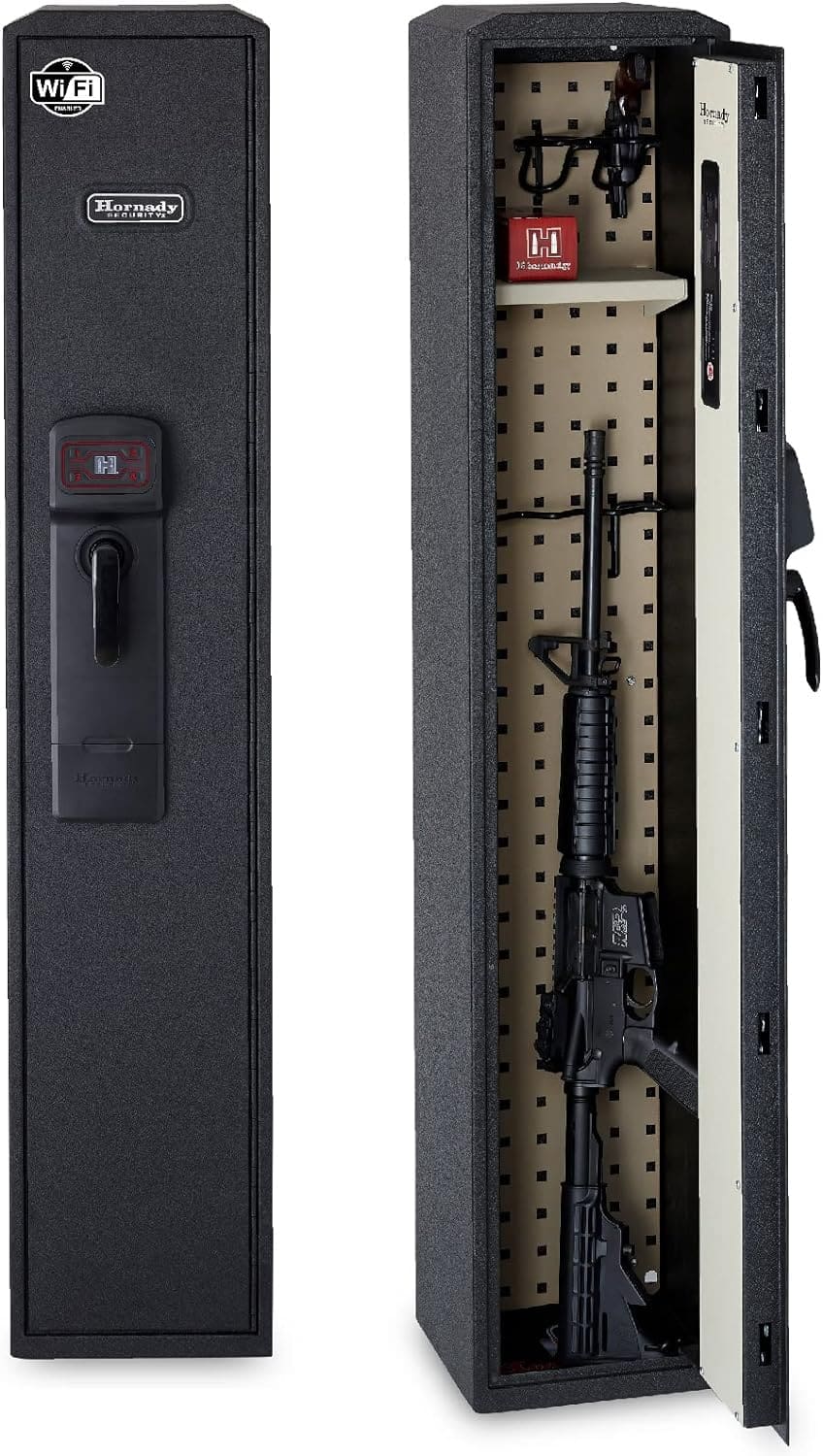

Most of the lower capacity 5-gun safes (sold online or in big box stores) are akin to gun cabinets/lockers and not gun safes (*read about the differences below).
They are just tall enough to hold most common rifle-length firearms and (depending on the stated capacity) wide enough to hold either 5 long guns or 10 long guns (and perhaps a few pistols and some spare mags with a little room left over for some ammo).
Some models have adjustable shelves that allow you to organize your guns and accessories as you see fit but others do not.
(*Some of the stated capacities may go down considerably if optics and accessories are mounted to your rifles. This is especially true where mounting fixtures or shelves are permanently affixed.)
1
The Good
- Can Hold a Decent Amount of Long Guns and Most Have Shelves For Pistols & Space For Ammo
- Most Are Under Well Under 250lbs
- Better Models Use Multiple Locking Bolts To Secure Door
- A Few Secure Entry Methods are Usually Included
- There’s a Model For Every Budget
- Reasonably Secure
2
The Bad
- Many Cheaper Models Are Made of Thinner Gauges of Sheet Metal
- It May Be Hard To Find A Good Place To Fit The Bulkier Models
- Need To Be Bolted Down To Prevent Tipping & Theft
- Most Offer No Fire or Adequate Theft Protection
- Will Not Stop A Determined Theif
3
Pro Tip
Find the best storage solution within your budget range with the features you need most. Beware of flimsy models with unreliable electronic locks.
You may be asking yourself…
What’s the difference between a gun safe and a gun cabinet?
Technically speaking, a gun safe is a secure storage container that is designed to protect firearms from unauthorized access, tampering, and damage.
Gun safes are usually made of thick, solid steel and are equipped with a reliable lock system, such as a keypad, biometric lock, or combination lock.
They are typically designed to be more secure and tamper-resistant than gun cabinets.
A gun cabinet, on the other hand, is a storage unit that is specifically designed to hold guns.
Gun cabinets are typically made of wood or metal and have glass windows or ventilated steel doors to allow the guns to be displayed.
They may also have lockable doors or drawers to help prevent unauthorized access to the guns.
Gun cabinets are generally less secure than gun safes and are not designed to withstand tampering or attacks in the same way that safes are.
They are typically used more for display or as a way to keep guns organized and out of sight, rather than as a primary means of security.
Overall, gun safes offer a higher level of security and protection for firearms, while gun cabinets are more geared toward storage and organization.
Everywhere you look online, the terms “gun safe” and “gun cabinet” seem to be used interchangeably without much explanation.
When asking what constitutes a true gun safe, you must consider the door of the safe and its locking mechanism.
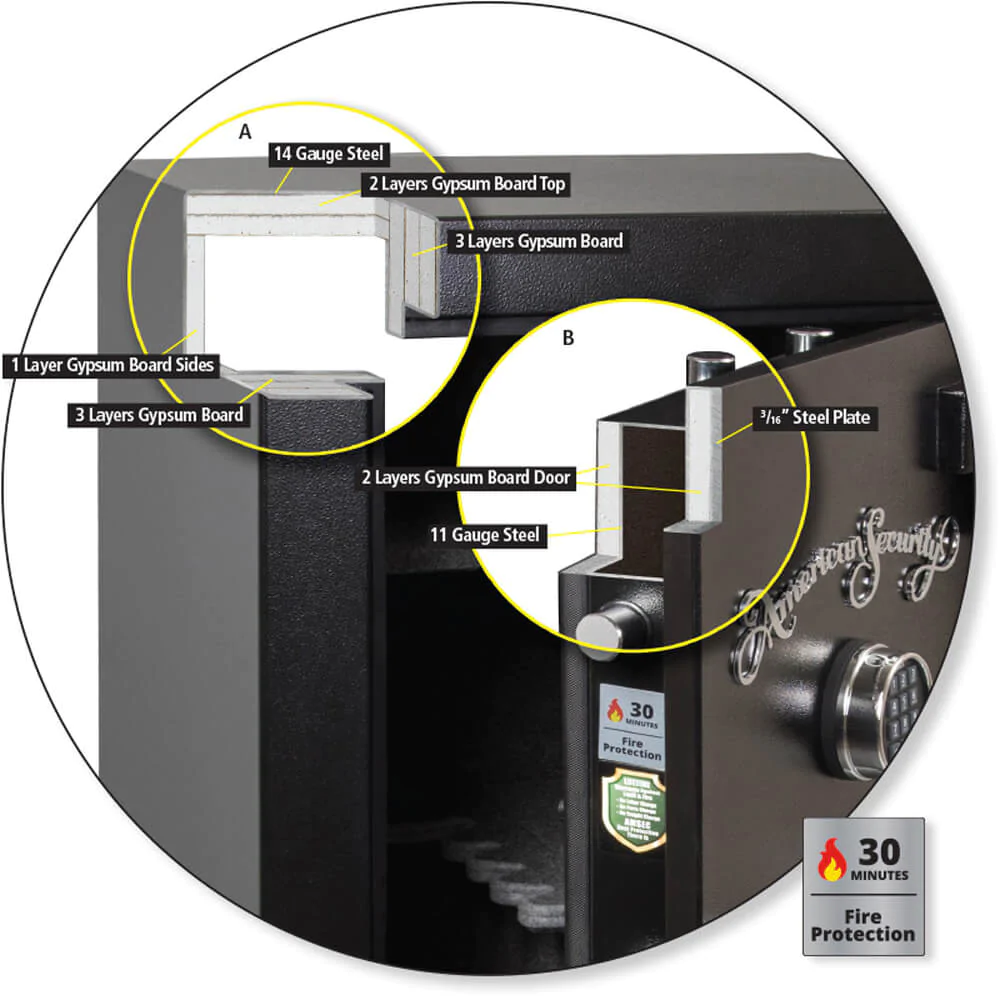

Actual gun safes should implement solid steel cylindrical bolts that pass behind a fully welded interior ledge or into recessed holes in the frame.
The most secure gun safes also add extra bolts on the hinge side of the door. When it comes to gun safes, the greater the number of bolts securing the door to the frame the better.
The diameter of the bolts and their depth of penetration are equally important.
Next, a true gun safe should have a minimum of 11 gauge steel in its door frame and the side walls should be no less than 14 gauge.
The outermost layer of the door face on high-security models is made out of a hardened steel plate of at least 3/16″ or thicker, making it nearly impervious to pry bar attacks.
Stainless steel or titanium drill plates placed behind the lock and other common points of attack can be used to dull and destroy drill bits.
Metal gun cabinets, on the other hand, do not lock into every side of the frame and many use shorter bolts of lesser diameter or locking bars that slide into adjacent slots in the frame either laterally or at the top and bottom.
The thickness of the steel used and the type of firewall added will determine how heavy, safe, and secure a gun safe will be in the event of a burglary, fire, or other natural disasters.
Most, if not all, gun safes and metal gun cabinets can be bolted down to the floor and wall studs to prevent theft or tipping.
What Are Some of The Common Steel Gauges Found In Gun Safes?
Gun safes and metal gun cabinets are made of sheet metal measured in “gauges” (like shotguns, the lower gauges denote a larger size).
The sides on most true gun safes are between 11-14 gauges and the door frame between 8-12 gauges. On average, high-security safe doors will have 1/4″-1/16″ plate steel fascia.
FYI: The steel gauge of a gun safe refers to the thickness of the steel used in the safe’s body and door. A lower gauge number indicates thicker steel, while a higher gauge number indicates thinner steel.
I used digital calipers to measure the gauge of 3 common wall thicknesses of cardboard to illustrate just how thin most safe walls are (safes are made out of an inner and outer wall of folded sheet metal welded onto a frame for added strength and rigidity).


The bottom is the slimmest cardboard I could find and it measures between 11-12 gauges, which is thicker than most safes use.
The middle picture shows the standard single-wall cardboard that most packages are shipped in and would be considered very heavy-duty at 9 gauges of thickness.
The first picture shows a double-walled cardboard sheet that measures in at a whopping 1/4″! On a safe door, that would be considered pry bar and tamper proof but would also add a lot of weight and added cost.
For reference, here are some common steel gauges that are found in gun safes:
- 14-gauge steel: This is the thinnest steel that is commonly used in gun safes. It is relatively lightweight and may be more prone to damage than thicker steel.
- 12-gauge steel: This is thicker than 14-gauge steel and is more resistant to tampering and damage. It is a good choice for a gun safe that will be used in a residential setting.
- 10-gauge steel: This is even thicker than 12-gauge steel and is more resistant to tampering and damage. It is often used in commercial or industrial settings where the safe will be subjected to more wear and tear.
- 7-gauge steel: This is the thickest steel commonly used in gun safes and is highly resistant to tampering and damage. It is often used in high-security settings or for storing very valuable firearms.
Overall, the steel gauge of a gun safe is an important factor to consider when shopping for a safe.
Just remember, thicker steel will generally provide more security and protection for your firearms, but it may also be more expensive and heavy.
Large High-Capacity Multi-Gun Safes:
Large high-capacity multi-gun safes are big enough to house multiple long guns and handguns, as well as spare magazines and a decent amount of ammunition.


These safes will be listed with the stated amount of guns they can hold so the buyer will know in advance which one they should buy to fit the size of their collection.
1
The Good
- Very Secure
- Thicker Gauge Walls & Reinforced Steel Doors
- Robust Locking Mechanisms
- Some Offer Fire & Theft Ratings
- Can Store Larger Collections
2
The Bad
- Very Heavy & Bulky
- Hard To Move
- Some Models Are Very Expensive
- Not Very Many Budget Options
- May Need Help Installing
3
Pro Tip
If you’ve got a large collection of firearms and want a centralized storage solution, this may be the best option for you. Buy the most expensive option you can afford and don’t skimp on important features.
The weight of these safes will go up with the gauge of steel used and so will the price. These safes are meant to be bolted down to prevent tipping and theft.
Expect to see a wide range of prices depending on the brand, feature set, capacity, locking mechanisms, and fire/theft rating.
Massive Multi-Gun Safes and Vaults:
Massive multi-gun safes and vaults are large investments reserved for those who possess a cache of weapons large enough to justify such an expensive purchase.
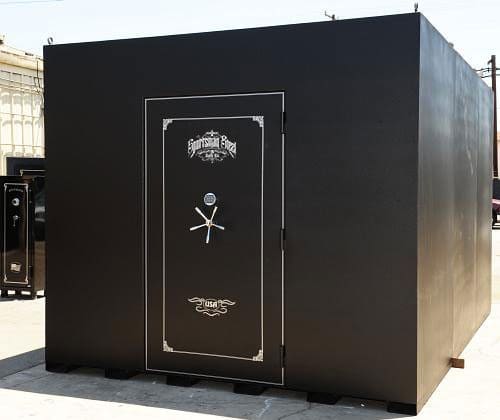

Some are mini vaults that look like walk-in closets while others are just very large double-door storage monsters!
1
The Good
- This Type of Safe Is The Most Secure Option
- Massive Amounts of Storage
- Tremendously Heavy & Impossible To Steal
- Independently-Tested For Fire, Theft, Water, And Drops
- Very Customizable And Made-To-Order
2
The Bad
- Most Cost A Fortune
- Extremely Heavy & Hard To Move
- Lots of Planning Involved To Install
- Takes Up A Lot of Space
- The Wife Will Hate You
- Might Have To Take Out A Second Mortgage
3
Pro Tip
If you’ve got a big enough house, with a collection of priceless family heirlooms and an arsenal that puts Call of Duty to shame, then why not?
On the high end, the sky is the limit (in terms of price and weight) and on the low end, you’re still going to be paying extra for the ability to store such a large amount of firearms.
They also sell vault doors that you can install to turn your room or closet into a massive storage space.
Most of these gun safes are so heavy it would be a herculean feat to tip one over even without the anchor bolts!
Bolting them down will make it all but impossible to move these massive safes.
Gun Safe Sub Categories:
Here, we’ve included 4 different subcategories of gun safes that do not quite fit into the 5 main categories above.
These are also very popular options for people with a particular need that isn’t quite met with the main gun-safe types above.
Gun Lockers:
Gun lockers are a quick-access gun storage solution that isn’t nearly as secure or heavy as an actual safe.
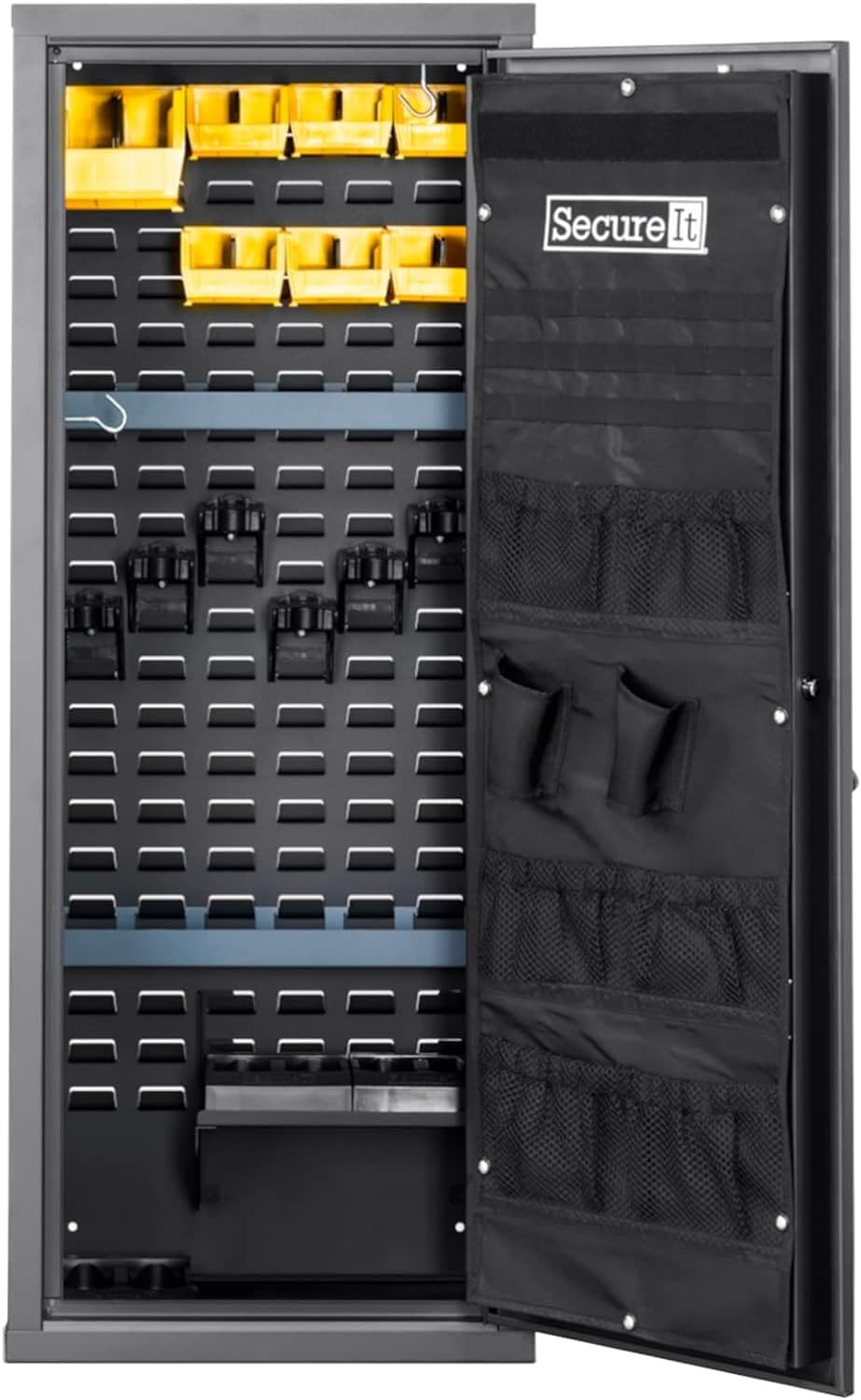

This sub-category of “gun safe” is just a slightly more secure version of a general-purpose locker and is designed for quick access, modularity, and ease of placement.
1
The Good
- Most Are Made To Store A Lot of Rifles, Magazines, And Accessories
- Have Secure Metal Frames That Can Be Bolted Down or Stacked
2
The Bad
- Most Options Are Rather Expensive
- Provides Less Theft Protection
- No Fire or Corrosion Resistance
- Contents Are Visible
3
Pro Tip
These are best secured in a secure room or vault since they provide no real theft protection. There are much cheaper options that may serve your needs better.
Metal gun lockers were made with a military application in mind, but are used by civvies as well.
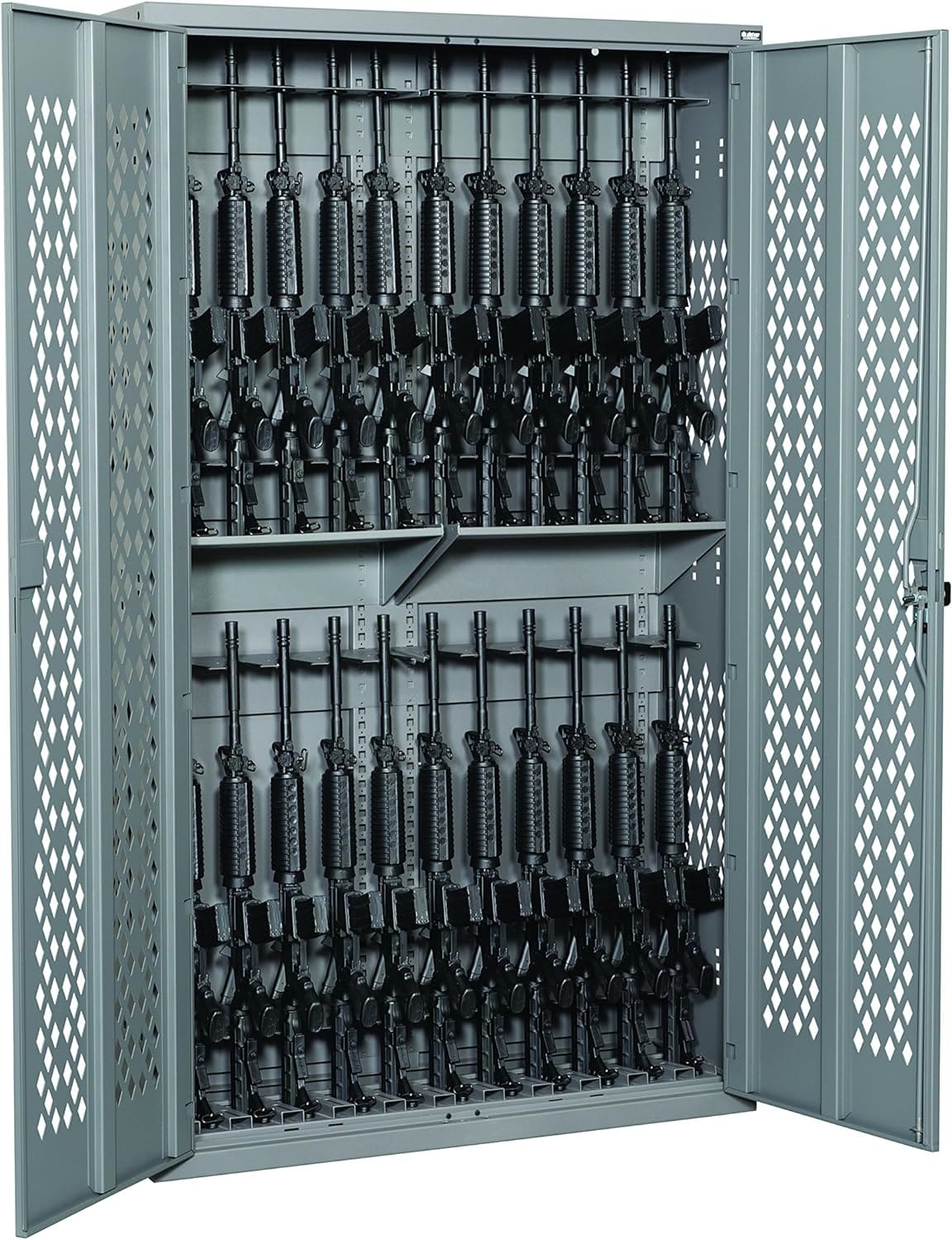

Gun Lockers provide a uniquely tactical solution since they typically allow for quicker access to the firearms inside and have more internal volume due to their thinner walls.
The design of the interior allows the user to quickly and easily remove rifles thanks to the clever use of barrel retention mounts on some models that keep the rifle secure in a vertical position at the perfect angle.
Gun lockers are not air-tight nor are they designed to be fireproof.
They’re made out of a thinner gauge of sheet metal all around which keeps them lightweight and easier to relocate.
The doors on most gun lockers are not solid sheets of metal but have a diamond pattern cut out so you can see if any guns have been removed at a glance.
Here are some of the US military requirements that gun lockers must adhere to:
- Cabinets should be fully welded using a heavy-gauge Steel
- Must be welded around a 4-post frame to provide cabinet strength and durability.
- Cabinet Walls must be at least 18 gauge steel.
- Cabinets must have a top and bottom.
- A minimum of 16-gauge steel.
- Cabinets should be able to stack on two levels.
- The structure must support at least 1,500 lbs.
- Visibility: Doors, sides, and back of the cabinet are perforated using a diamond mesh pattern to allow visible counts and weapon inventories to be taken even though the cabinet is closed and locked.
They’re best used for tactical placement within a home and can be bolted down to prevent tipping and theft.
They are much easier to break into seeing as they’re secured with a simple padlock and provide no fire or water protection- so keep that in mind if you’re concerned about protecting what’s inside.
Wood Gun Cabinets:
Wood gun cabinets are for those who like having a secure way of displaying their long guns with that classic wooden furniture aesthetic appeal.
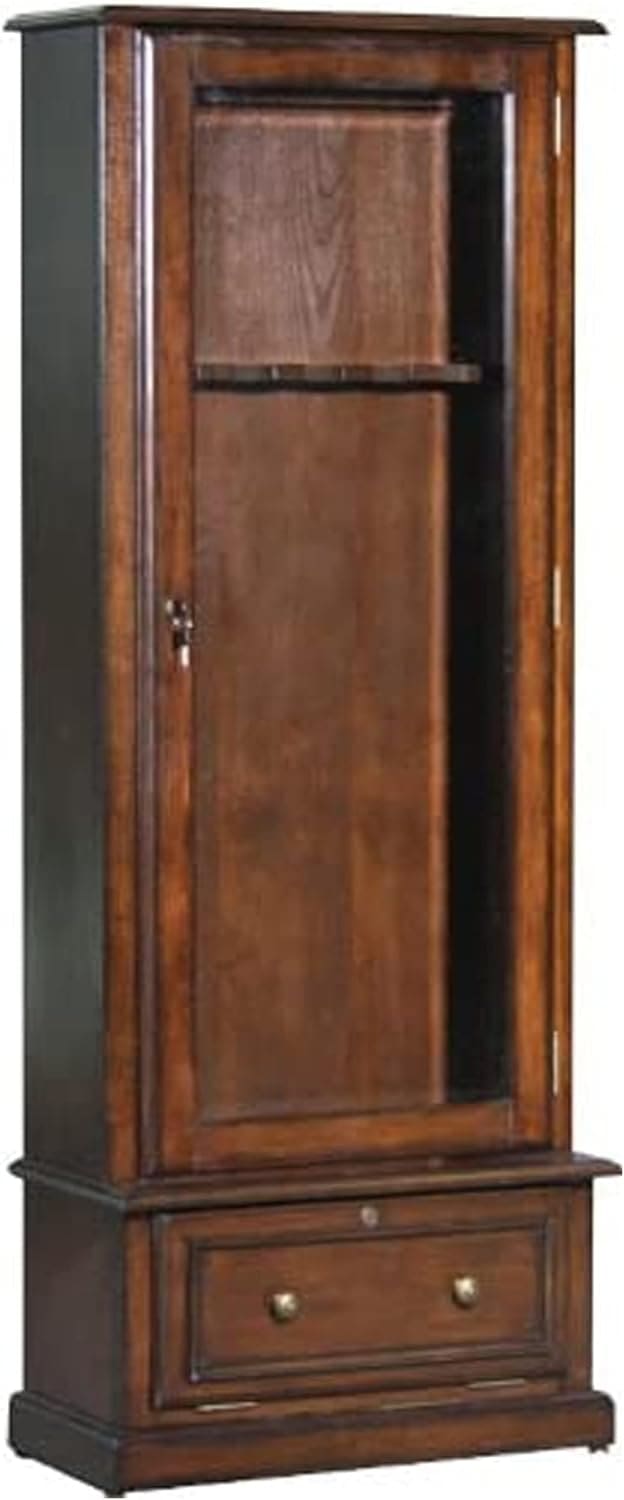

These are by far the least secure utilizing a simple keyed lock and glass panels that could easily be broken (not all have glass panels).
1
The Good
- Aesthetically Pleasing
- Can Store A Lot of Long Guns
- Comes In A Variety of Sizes, Shapes, & Colors
- Lots of Affordable Options
2
The Bad
- Bulky and Heavy Like Most Big Furniture Pieces
- Not Very Secure At All
- Good For Storage But Not For Theft, Fire, or Flooding
3
Pro Tip
If you’re in a rural area with a low crime rate and not in a dry fire zone then a simple wood gun cabinet is a very affordable way to store a good amount of firearms out of the reach of children.
Long guns stored in these wooden gun cabinets should also have some type of trigger lock for an extra layer of protection as well as be unloaded.
These aren’t ideal for quick access or theft and fire protection but mostly for admiring your collection while keeping them safely away from the kids.
In-Wall Gun Safes:
In-Wall Gun Safes are fairly common and a good way to hide a firearm behind a painting or piece of furniture that can be quickly accessed when needed.


They vary quite a lot in price and size and are typically secured in between the studs in a closet wall and opened with an electronic keypad that may use fingerprint scanners.
1
The Good
- Can Be Hidden
- Won’t Take Up A Lot of Space
- Can Be Accessed Quickly
- There Are Options For Every Budget
2
The Bad
- You May Need To Hire Help To Install
- Not Fireproof
- Easier To Break Into Due To Relatively Thin Steel
- Can Be Expensive For Larger Long Gun Models
- Permanent Hole In Wall
3
Pro Tip
This is the best solution for those who want to hide their safe out of sight. Smaller ones are much cheaper and easier to find a place to install.
Most use a medium gauge carbon steel that is fairly secure though may not hold up to a heavy pry bar for long.
It’s best to find a way to hide these types of safes instead of relying upon their built-in security!
In-Floor Safes:
In-Floor Gun Safes are a good solution that can be hidden a bit easier than in-wall gun safes.
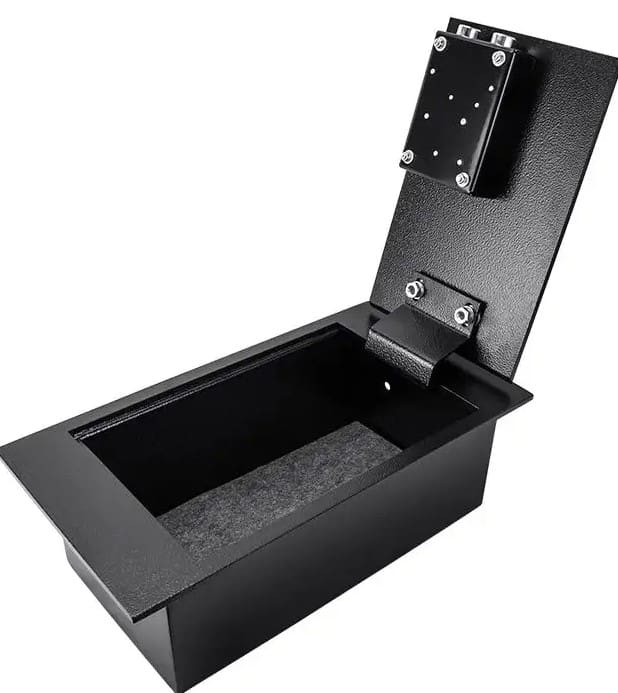

The models available tend to be very heavy-duty and are built like mini vaults under your floor. Some budget models are not as tough but if hidden well it shouldn’t matter that much.
1
The Good
- Lots of Places To Hide These
- Budget Options Available
- Doesn’t Take Up Living Space
- Wife Approved
2
The Bad
- Can Get Pricey For Larger Storage Options
- Must Destroy A Part of Your Flooring
- Depending On Location, It May Not Be Quick To Access
3
Pro Tip
- These may be a good option for those wanting a truly hidden gun safe that’s out of sight and can be strategically located for quick access.
Most offer no real protection from fire or flood and most can be defeated easily with the right tools (there may be some exceptions to this but it’ll cost you).
The best security you get with these safes is hiding them well!
Hidden In Plain Sight Gun Safes:
These dual-purpose furniture safes hidden in plain sight (often with hidden compartments) are kind of a cool idea but also very gimmicky and risky if you want my honest opinion.
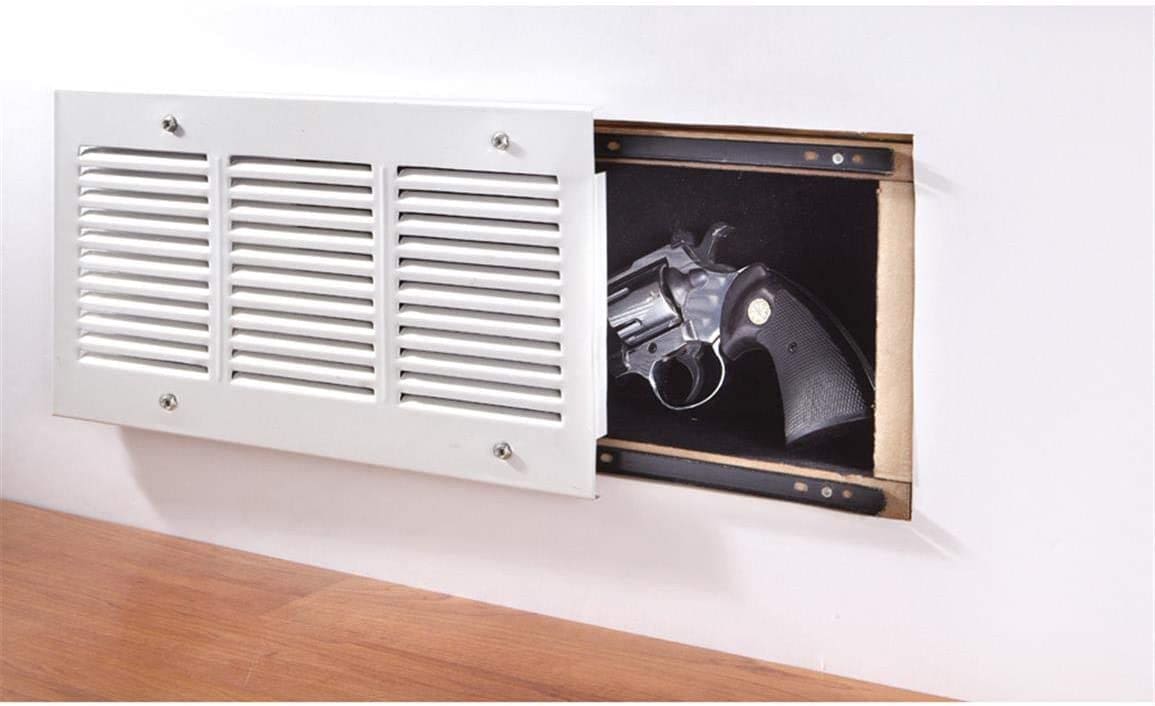

If discovered, your firearm is as good as gone but perhaps I give criminals more credit than they deserve.
1
The Good
- Most Options Are Very Affordable
- Probably The Most Aesthetic Choice
- Allows For Quick Access To Firearms
- The Wife Won’t Complain
2
The Bad
- The Least Secure Option If Discovered
- Not A lot Of Variety Available
- Kind of Stressful To Depend on “Stealth”
3
Pro Tip
This may work for you but is it worth the anxiety? There are very few options so a lot of people will know what most of these look like. Use these with a lot of caution or put a Taurus in there and call it a day!
They should do a good enough job keeping kids out but that’s about all you can count on them to do- and maybe not even that depending on how well they’re made.
Remember, most of these are constructed out of wood and not steel. Use at your own risk!
Gun Safe Quality Tiers:
To keep this simple, there are essentially 3 tiers of build quality that separate gun safes based on their overall build quality and the level of security they provide.
Size, weight, capacity, and added features (both internally and externally) scale in price, as one might expect.
The following list is what you’ll likely come across online or in retail stores:
Tier-1: Commercial Grade Gun Safes
Tipping the scales at 1,500 lbs or more, these commercial safes are on the higher end of the price spectrum (normally found in boutique security stores that specialize in their respective fields, e.g., locksmithing, safes, home security systems, or all of the above).
These safes will command the highest prices since businesses require the highest quality available.
They use the thickest possible 8-10 gauge steel to build their fully seam-welded frames and are independently rated by one of several accredited labs (such as UL) for fire, burglary, drops, prying, drilling, and grinding to determine the time rating of each.
For firewall materials, the top-end models will utilize composite cement between the inner and outer walls of the steel and will receive a certified UL fire rating.
These commercial gun safes will incorporate additional metal at central points of attack to protect them from drilling and most have break-away relocking features that activate when excessive force is applied to the handle or locking wheel.
Tier-2: Consumer-Grade Gun Safes: Consumer-grade safes typically use a fireboard or multiple sheets of gypsum as their primary fire defense layer (and may utilize a private, or in-house lab, for its rating- or opt for the industry-standard UL rating).
This is the quality tier I would recommend for most end users since it strikes a nice balance between cost and security.
Pro Tip: If you can afford to spend a bit more, pass on the low-end options below and get one of these instead!
Tier-3: Entry-Level Gun Safes: These low-end budget safes manufactured in China will not have any fireproof layer within the walls of the safe (though some falsely advertise such).
Gun safes without any insulation can be made with thinner walls which means they should have a larger internal volume allowing you to store more firearms inside.
The trade-off is poor fire protection and theft resistance. They’ll also incorporate cheaper locking mechanisms with fewer bolts that are not very strong.
So, Are Cheap Gun Safes Worth It?
A gun safe is a must for any responsible gun owner, but not everyone can afford a top-of-the-line model. So is it worth it to buy a cheap gun safe?
The answer to that question depends on your needs and budget. If you’re looking for a safe that’s just going to store your guns and nothing else, then a cheap option may be all you need.
But, if you want something that will protect your firearms from theft and fire, then you’ll need to spend quite a bit more money.
There are plenty of affordable gun safes on the market, so do your research and find the one that’s right for you.
Just make sure that whatever safe you choose meets the requirements of your state and local laws, as well as you’re own personal needs.
Can I Put a Gun Safe in My Bedroom?
It is generally considered safe to put a gun safe in a bedroom, provided that the safe is securely anchored to the floor or wall and is out of reach of children or unauthorized individuals.
However, it is important to consider the specific location of the safe within the bedroom.
For example, it may not be a good idea to place a gun safe in a location that is easily accessible from outside the bedroom, such as near a window or sliding glass door (it is also important to consider the type of gun safe you are using).
If you are using a gun cabinet, which is generally less secure than a gun safe, it may not be a good idea to store firearms in a bedroom due to the risk of unauthorized access.
Overall, the best location for a gun safe will depend on the specific circumstances and layout of your home.
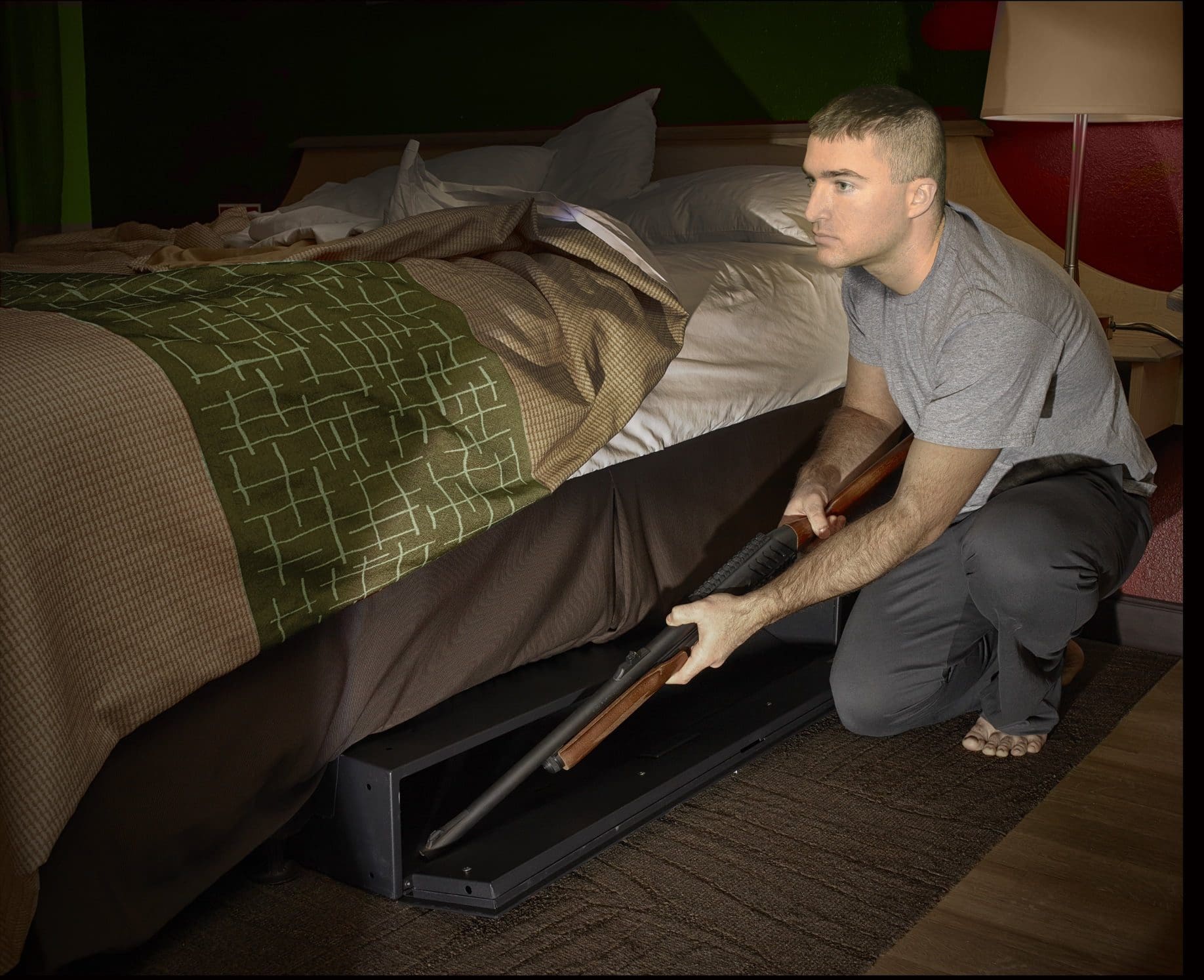

If, after considering all of the above, you have determined that your bedroom is ideal for a gun safe, (safe size and room layout are extremely important), make sure you have enough clearance to open the safe door.
You also need to be able to reach the guns stored inside easily in case of an emergency.
If your bed is against a wall, consider buying a gun safe with a door that swings open instead of one that slides out. This will give you more room to work with.
Is a Fireproof Gun Safe Worth it?
There is no doubt that a fireproof gun safe can provide an added layer of protection for your firearms in the event of a house fire.
However, these safes can be quite expensive, and may not be worth the investment if your home has fire mitigation systems in place or the city you live in has a low risk of fires due to drought.
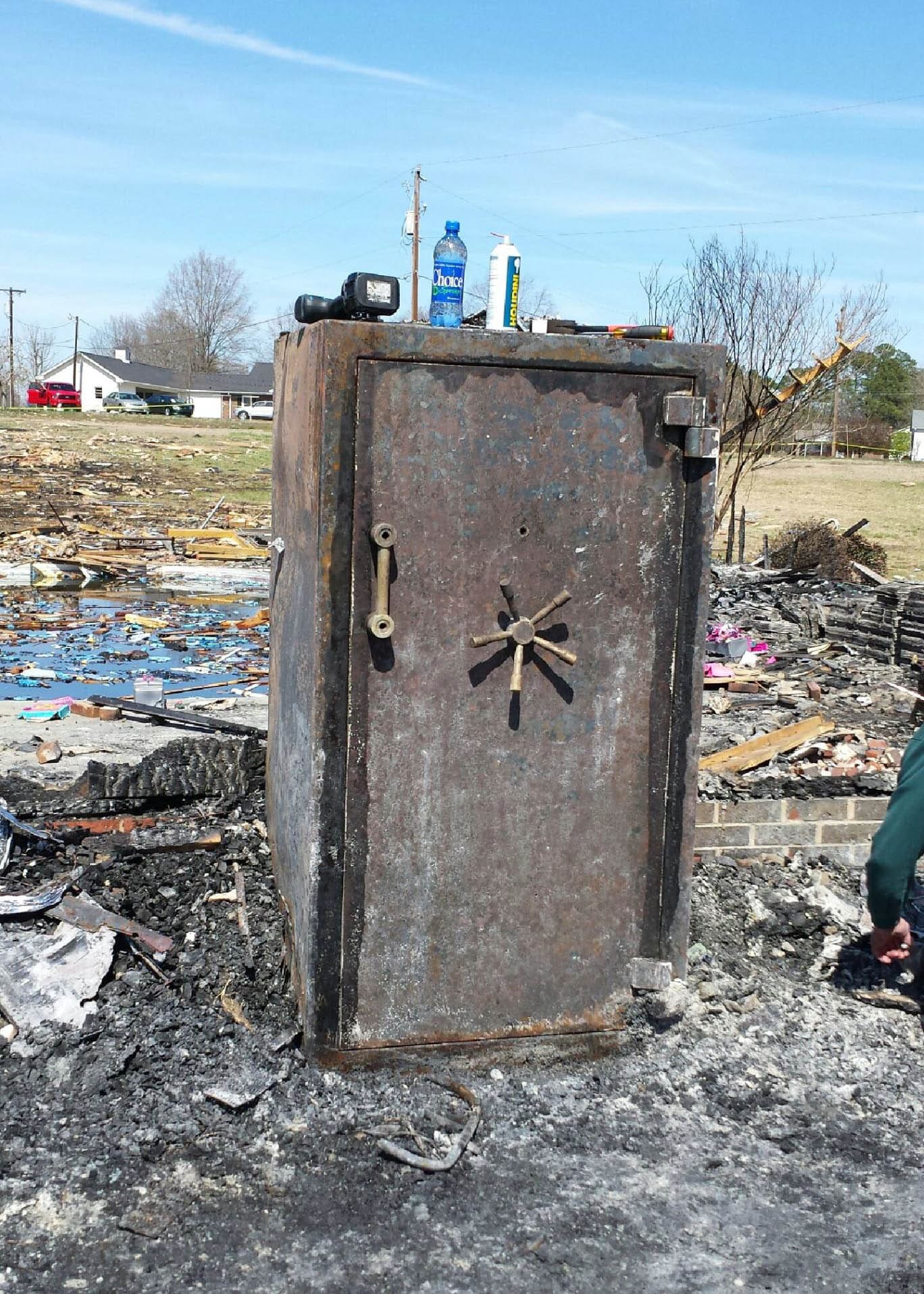

All fireproof safes have a fire rating. A fire rating simply indicates that a safe can resist fire for a specified time.
To preserve paper documents’ integrity, the interior of the safe must be kept below 350°F. There are two levels of protection available.
The firewall (usually made of drywall or fireboard) is the lining of a safe that protects contents from external fire by protecting the safe’s exterior and its contents.
Both fireboard and drywall contain Gypsum, (which is a mineral that is made from calcium sulfate) and is the most commonly used firewall liner for gun safes.
Before purchasing a fireproof gun safe, you should consider how likely it is that your home will catch on fire.
If you live in an area that experiences frequent house fires, then a fireproof safe is worth the investment.
However, if you live in an area with low fire risk, then a standard gun safe may be adequate protection for your firearms.
Another thing to consider when deciding whether or not to purchase a fireproof gun safe is the size of your collection.
Fireproof safes have less internal volume than non-fireproof safes of the same external dimensions.
If you only have a few firearms, then a standard gun safe will likely be big enough to store them all.
If you decide that you do indeed need a fireproof safe, here are some questions you should ask yourself:
What Fire Rating Do I Need For My Safe?
Every gun owner must decide what level of fire protection they need.
These are some factors to consider:
What time will it take for the fire department to reach you in the event of a fire? Do you plan on keeping important documents or cash inside your gun safe?
What is the safety rating of the safe? How was the safe tested? FYI: Paper will turn brown at 350°F, char at 405°F, and burn at 451°F.
Below are the 5 classes of fire rating and the max time and temperature to qualify for that class.
| FIRE CLASS RATING | TIME IN FURNACE | MAX TEMPERATURE |
| Class A | 4-hrs | 2000°F |
| Class B | 2-hrs | 1850°F |
| Class C | 1-hr | 1700°F |
| Class D | 1-hr | 1700°F |
| Class E | 30-mins | 1550°F |
Several different sources can provide fire ratings that safe manufacturers use depending on where the safe is made:
- Private Laboratory Testing (Least vetted method)
- European and Asia fire rating standards
- U.L. (Underwriters Laboratory) Class of Fire Protection based in the US and recognized globally in over 100 countries.
A lot of manufacturers use a private, or in-house, laboratory to test their burglary and fire safes to determine their fire rating, and may not be the best choice if you want a guaranteed fireproof or theft rating that insurance companies will cover.
The U.L. fire rating is the most recognized, thorough, and coveted fire testing available and will provide you with the most peace of mind in the event of a fire.
How Much Should I Spend on a Gun Safe?
When it comes to gun safes, there are a lot of things you’ll need to carefully consider when trying to determine how much you should spend.
One important thing to keep in mind is that you usually get what you pay for. A cheap gun safe may not be the best option but is always better than no safe at all.
The amount of money you should spend on a gun safe will depend on several factors, including the size and type of firearms you own, the level of security you need, and your budget.
Here are a few things to consider when determining how much to spend on a gun safe:
- Size: The size of the safe you need will depend on the number and type of firearms you own. Make sure to measure the length, width, and height of your guns to ensure they will fit comfortably inside the safe.
- Security: Consider the level of security you need. A gun safe with a thick, solid steel body and a reliable lock system is generally more secure than a cheaper model with a thinner body and a less reliable lock.
- Fire protection: If you live in an area prone to fires, you may want to consider a gun safe that is rated to withstand high temperatures.
- Ease of use: Consider how easy the safe is to open and close. A safe with a keypad or biometric lock may be more convenient than one with a traditional key lock.
In general, gun safes can range in price from a few hundred dollars to several thousand dollars.
It is a good idea to do a lot of thorough brand research and compare prices before making your final purchase.
Ultimately, the amount you should spend on a gun safe will vary depending on your specific needs and budget.
That said, many affordable gun safes on the market can provide adequate protection for your firearms.
If you have a limited budget, here are some tips for finding the best deal:
- Shop around and compare prices. There are many online retailers, as well as brick-and-mortar stores, that sell gun safes…so, be sure to compare prices before making a purchase.
- Consider buying a used, open box, or refurbished gun safe. There are many used and refurbished gun safes available online, in retail stores, or you can try classified ads.
How Easy Is it to Break Into a Gun Safe?
Gun safes are marketed as a way to keep firearms and ammunition secure and out of the wrong hands, but are they effective at preventing theft?
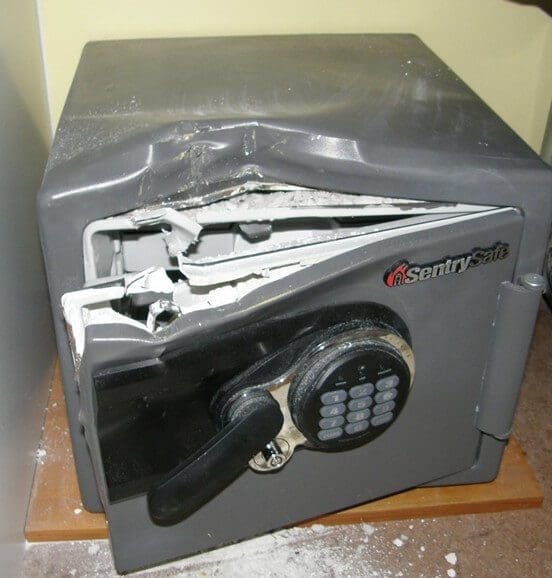

With a few exceptions, most gun safes can be broken into relatively easily, especially if the thief has the proper tools and enough time.
Many gun safes can be opened with a simple screwdriver or crowbar, and some even have combination locks that can be easily cracked.
One way to make it more difficult for a thief to break into your gun safe is to use a digital lock instead of a combination lock.
Digital locks are much harder to crack than combination locks. Check out the video below to find out!
Another way to make your gun safe and more secure is to bolt it to the floor or wall.
This will prevent the thief from simply picking up the safe and walking away with it.
The main deterrent is a well-built gun safe that utilizes thicker steel walls and reduces any gaps to prevent easy access using pry tools.
The ease with which a gun safe can be broken into will depend on several factors, including:
- The type of lock system the safe uses.
- The thickness and strength of the safe’s body and door.
- The tools and techniques that are used to try to break into the safe.
In general, gun safes with thicker solid steel bodies with reinforced doors are more resistant to tampering and are more difficult to break into than safes with thinner bodies and doors.
Pro Tip: Strategically mounting your safe in a good location will make it harder for thieves to find, and can take away the leverage needed for successful pry attacks.
Reliable lock systems, such as keypad locks, biometric locks, and combination locks, can also make it more difficult to break into a gun safe.
However, it is important to reiterate that no gun safe is completely impregnable! With the right tools, techniques, and time, an experienced thief can break almost any safe.
That being said, the vast majority of gun safes are designed to be resistant to some tampering and should provide a level of security that, (at the very least), will keep firearms out of the hands of children, while keeping honest people honest.
Overall, the best way to protect your firearms and other valuables is to use a gun safe with a reasonably thick steel body and a reliable locking system, (remembering to keep your safe in a well-hidden and secure location that is well out of reach of unauthorized individuals).
Should You Bolt Down a Gun Safe?
While many gun safes come with a built-in mounting system, some people choose to bolt their gun safes down for extra security.
So… should you bolt your safe down? Bolting a gun safe to the floor or wall is a great way to deter theft and keep your firearms secure.
It also makes it more difficult for someone to steal the safe itself!
Bolting a gun safe to the floor or wall will provide an extra layer of security against theft. It can also help keep the safe in place in the event of a natural disaster.
If you’re thinking about bolting down your gun safe, here are some things to consider:
First, make sure the floor is sturdy and can handle the weight of a heavy safe and its contents being bolted to the floor.
Secondly, check with your local authorities to see if there are any restrictions or ordinances related to bolting a gun safe down.
Lastly, after you’ve determined that bolting your gun safe down is the best option for you, follow these simple steps to make sure the job is done right:
- Choose the right spot: You’ll want to choose a spot where the safe will be stable and unlikely to move in the event of an earthquake or other natural disaster.
- Then, measure the location where you will be bolting your safe to the floor. Make sure there is enough room on all sides of the safe so that you can work comfortably.
- Next, mark the spot where you will be drilling and use a level to make sure it is perfectly straight.
- Drill a hole in the floor at each mark and insert the bolts. Be sure to use a washer and nut on each bolt, and tighten them securely.
- Test the safe by trying to move it around. If it moves at all, go back and tighten the bolts some more. Once you are satisfied that it is firmly in place, congratulations!
Should a Gun Safe Be Hidden?
There are instances where hiding a gun safe can be a good idea and we’ll cover those instances here.
To start, smaller gun safes are ideal for hiding due to their size. You can have multiple handgun safes hidden in strategic locations so you can get quick access to a firearm regardless of where you are in your house.
You can hide a small safe in a bathroom cabinet, bedside table, closet, or laundry room.
These will preferably be quick-access safes that can be opened with an analog push-button code, electronic PIN, RFID tag, a biometric fingerprint reader, or a key.


Larger gun safes, lockers, or cabinets that can store many rifles, shotguns, handguns, and magazines are not as easily hidden but can be placed in a strategic location for easy access and bolted down to prevent tipping and theft.
This will greatly reduce the leverage of pry attacks and will prevent the gun safe from being lifted or removed.
Gun safes used strictly for long-term storage can be hidden behind a false wall or in a basement where they can be walled-in and hidden behind a cover or dresser.
Depending on the type of gun safe you have- and the purpose it serves- will determine where it should be placed and if it needs to be hidden.
Most people agree that a small gun safe should be hidden from any minors or guests in the house who are not of age or do not have any firearms safety training.
Are Gun Safes Bad For Guns?
Are gun safes really bad for your guns? This is a question that many gun enthusiasts have asked, and there is no clear answer.
Some people believe that gun safes can cause corrosion on firearms, while others believe that they are necessary to keep guns safe.
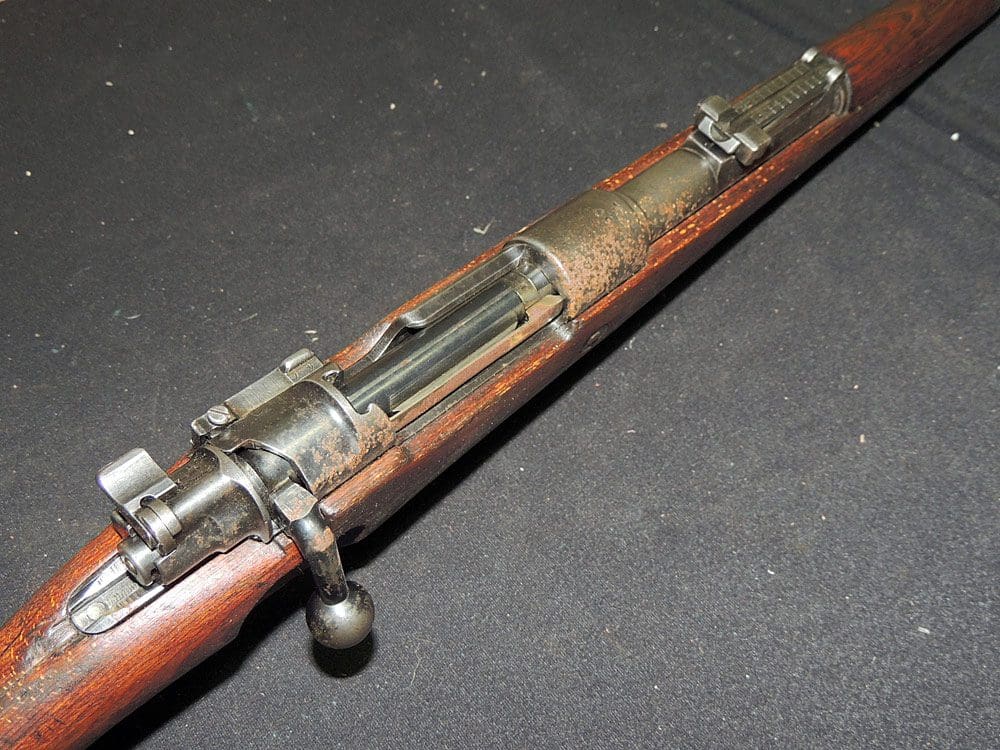

The truth is that there is no definitive answer when it comes to the effects of gun safes on firearms.
However, there are some things that gun enthusiasts should consider before deciding on whether or not to use a gun safe for long-term storage.
One of the main concerns about gun safes is corrosion. Corrosion can occur when firearms are stored in humid environments, and this can be a serious issue for guns.
Gun safes can create humid environments, which can lead to corrosion on firearms.
You can prevent some of these issues by putting a dehumidifying device inside the safe and installing the safe in a temperature-controlled environment.
It’s also a good idea to keep your firearms well-lubricated before putting them into storage over long periods.
There are also special bags that you can put your guns into that prevent corrosion.
Where is the Best Place to Keep a Gun Safe?
The best place to keep a gun safe will depend on its purpose and, of course, its size.
If you want to have quick access to a handgun, you should own a few small gun safes and hide them in strategic locations throughout the house that nobody else but you can easily find.
This can be a locked desk, a hidden drawer, or a wall safe behind a painting. If you’re good at hiding things, by all means, get creative!
Long gun safes and gun lockers are best kept in a dedicated spot preferably up against a corner and bolted down to make pry attacks extremely difficult.
If the gun safe has thinner gauge side walls, you may want to mount it inside the wall to protect its weakest spots.
Many gun owners choose to put their gun safe in the basement which comes with its own set of challenges and setbacks.
Basements can sometimes flood and cement floors are porous and collect moisture so you must put a good layer of rubber matting underneath your gun safe to protect it from the elements.
Home defense quick-access gun safes for rifles or shotguns should be installed under your bed or in a nearby closet so you can gain access to them in a timely fashion.
In-floor or under-the-floor gun safes are good options if you want something completely hidden but still quickly accessible.
Is it OK to Keep a Gun Safe in a Garage?
There is no definitive answer as to whether or not it is safe to keep a gun safe in a garage.
Some experts say that it is perfectly fine, as long as the gun safe is properly anchored down.
Others warn that garages can be susceptible to fires and other disasters, which could potentially result in the safe being damaged or destroyed.
It is often the case that when people end up putting their gun safes in a garage because it’s the easiest way to install a large and heavy safe.
There are a lot of reasons why this is a bad idea and we’ll list those reasons below.
Ultimately, it’s up to you whether to take our advice or take your chances.
Main reasons NOT to store your safe in a garage:
- Garage doors are large and closest to alleys, driveways, and sidewalks.
- Garages often contain the means to open most safes.
- Garages often contain flammable substances.
- Garages are often not temperature and humidity-controlled.
- Garages are a target for most thieves.
- If your garage faces a busy street or road people are likely to see what’s inside.
If you do decide to keep your gun safe in a garage, make sure you do these things:
- Find a location adjacent to the entry door of the house.
- Bolt the safe down in a corner wall with the safe door opening nearest the wall.
- Use a dehumidifier device inside the safe to collect moisture and prevent corrosion.
- Keep any cutting tools and pry tools locked away or at least well hidden.
- Install a security camera inside the garage and outside the house.
- Buy the heaviest and most secure gun safe you can afford from a reputable manufacturer.
- Make sure your safe has a good UL fire rating and keep a fire extinguisher nearby.
How Long Will a Gun Safe Last in a Fire?
Fire is a serious threat to any gun safe. How long a safe will last in a fire depends on the type of safe, the fire protection it offers, and the conditions of the fire.
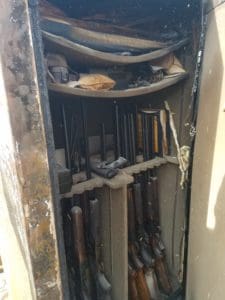

Most high-security fireproof gun safes are made of a thicker 10-12 gauge steel body with a concrete composite aggregate material poured between the walls and cured in a large oven.
The thickness of the fully seam-welded steel walls that fuse the body to the frame is what makes the safe strong enough to protect your firearms from would-be thieves.
This steel is also the most vulnerable part of the safe in a fire as it conducts heat very well.
This is much less of a problem for gun safes that cured concrete since the inner and outer walls do not physically touch through the frame and this slows the transfer of heat considerably.
The fireproofing material protects the contents of the safe from heat and flames, but it can crack or crumble in extreme conditions.
Many fire-resistant gun safes offer at least 30 minutes to 1 hour or more of protection against fire.
If you live in an area that is at risk for wildfires, you may want to consider a safe that offers even more protection (up to 2 hours) backed up by a good fire insurance policy.
Chances are, no matter how much fire rating a safe may have, if it sustains external temperatures greater than 1,400 degrees for more than an hour, the internal heat will continue to rise until the contents succumb to the effects of the heat.
What Accessories Go in a Gun Safe?
A gun safe is a great investment for anyone who owns firearms, but what accessories should you consider buying to put in your gun safe?
One essential accessory is a gun rack if your safe has some shelves to support it. This will help you organize your firearms and make them easy to access when you need them.
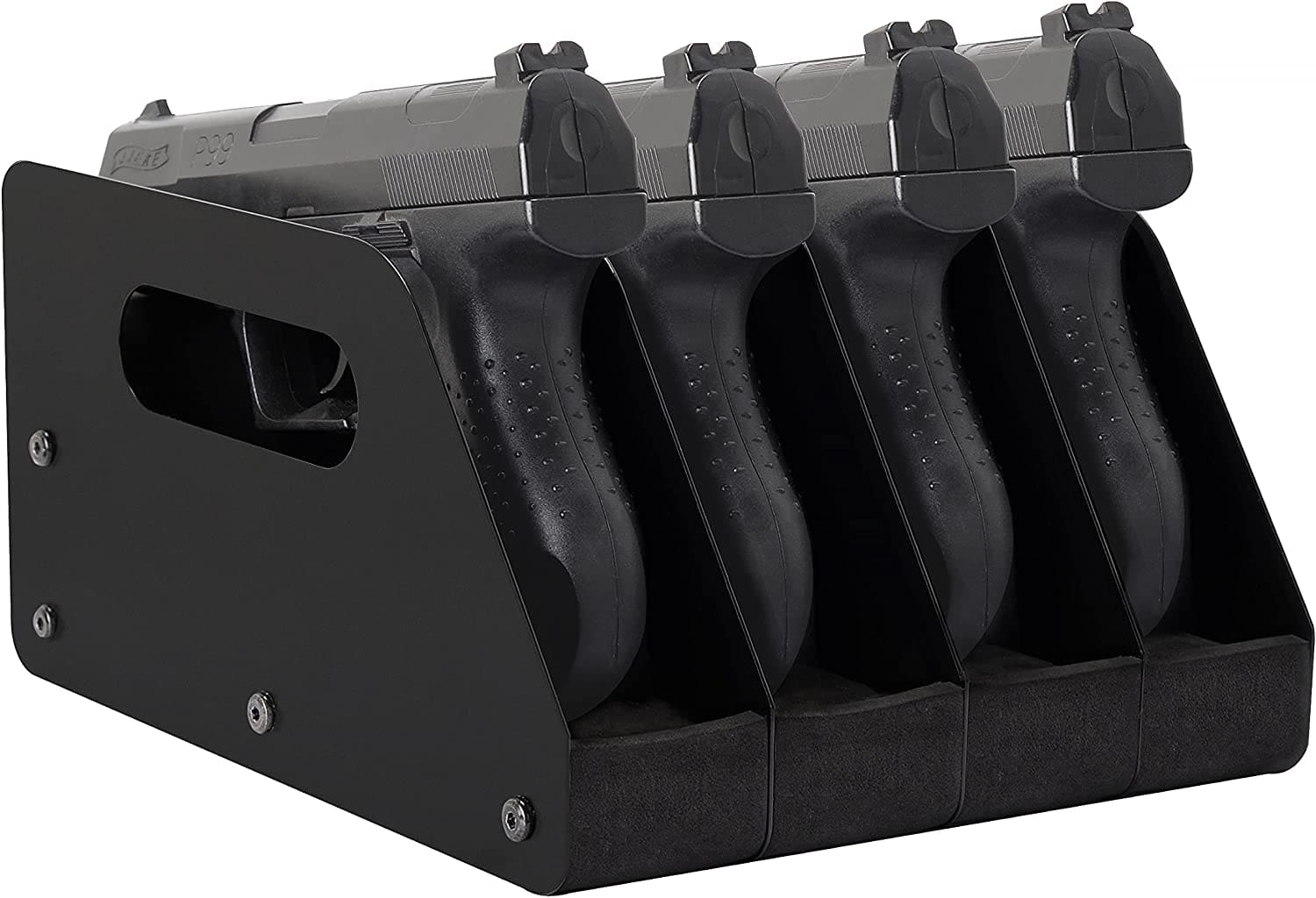

Rifle rods are great for keeping your long guns stable inside the safe so they stay in place and won’t fall on each other and sustain scuffs and scratches.
These stick to the top of the felt liner using a disc of velcro and slide down the barrel to keep everything in place.
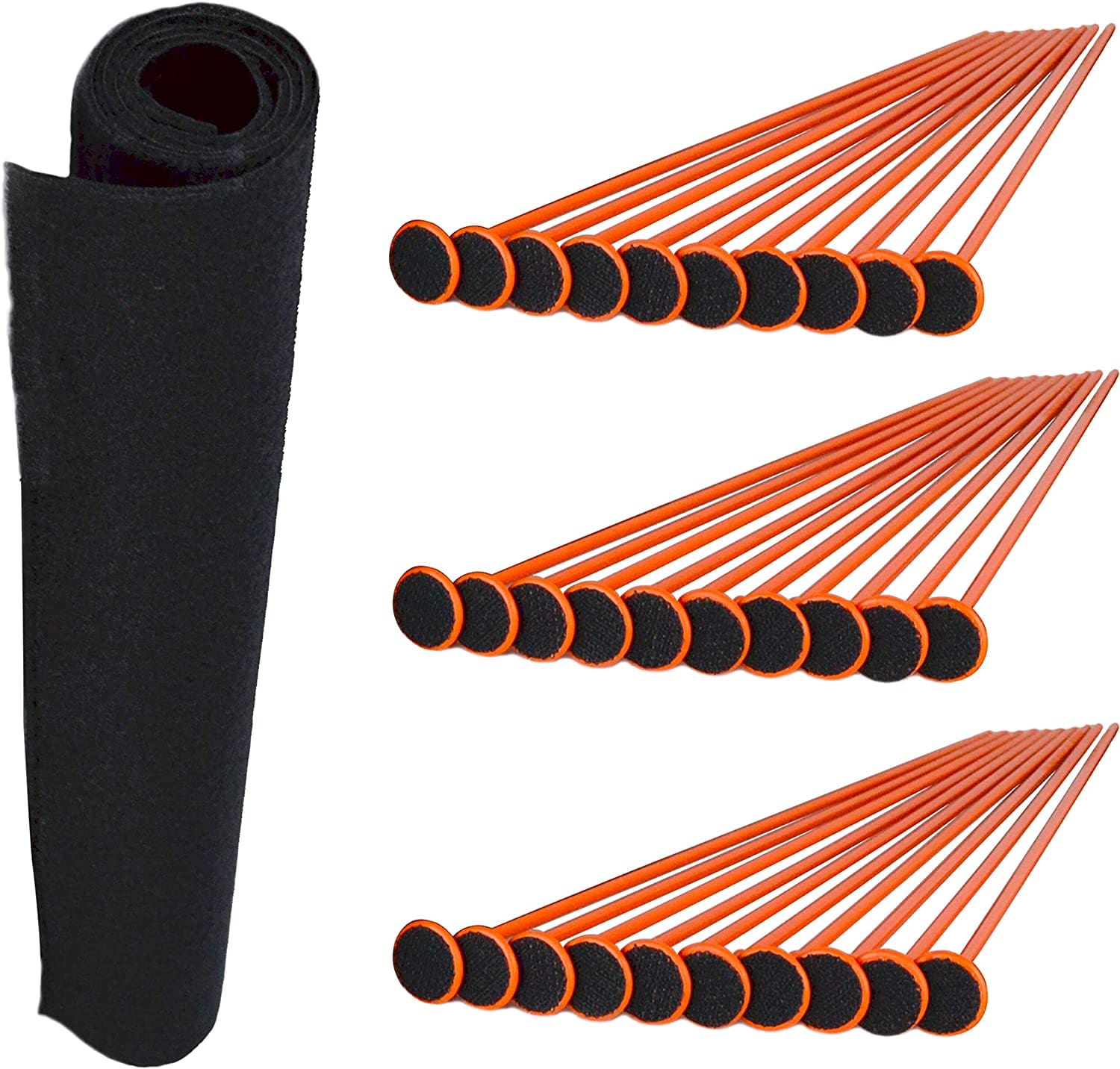

It’s also a good idea to buy an attachable nylon door panel organizer that has a variety of pouches and pistol holders that add additional spaces for spare magazines, accessories, or boxes of ammunition.
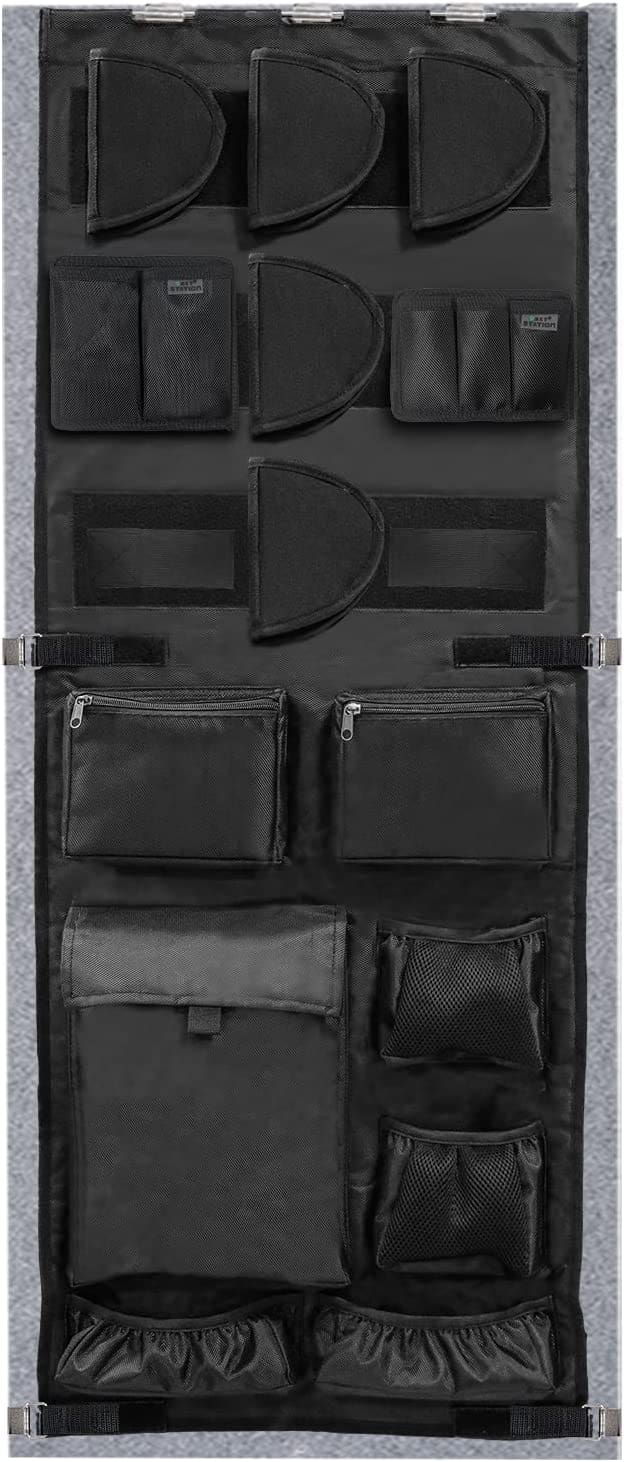

For gun safes that don’t come with any built-in lighting solution, they make motion-activated LED lights that you can mount with built-in magnets that can be positioned just about anywhere there’s space to mount them.
This will provide more than enough light to allow you to easily see your guns inside when the lights are off.
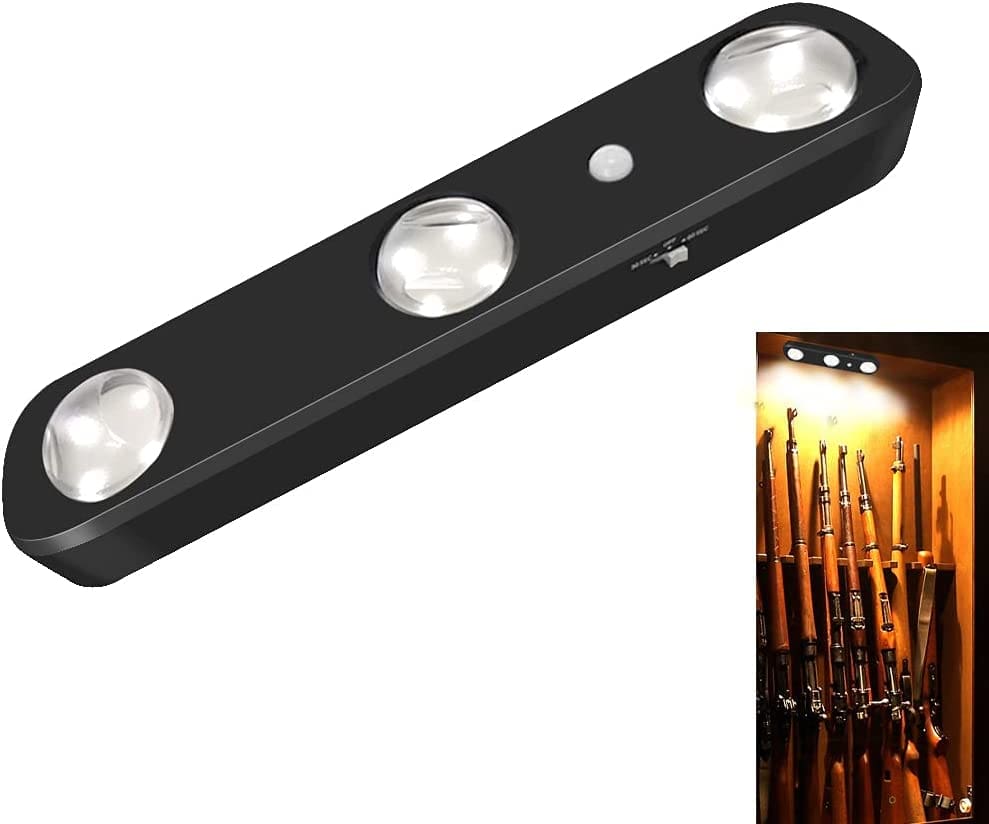

A way to monitor the humidity inside of your safe is a must if you keep your safe in the garage or basement.
An electronic humidity and temperature LCD-display is a great way to do just that.
This device wirelessly connects to a probe inside the safe with the display placed nearby so you can always tell with a glance what’s going on inside of your safe.
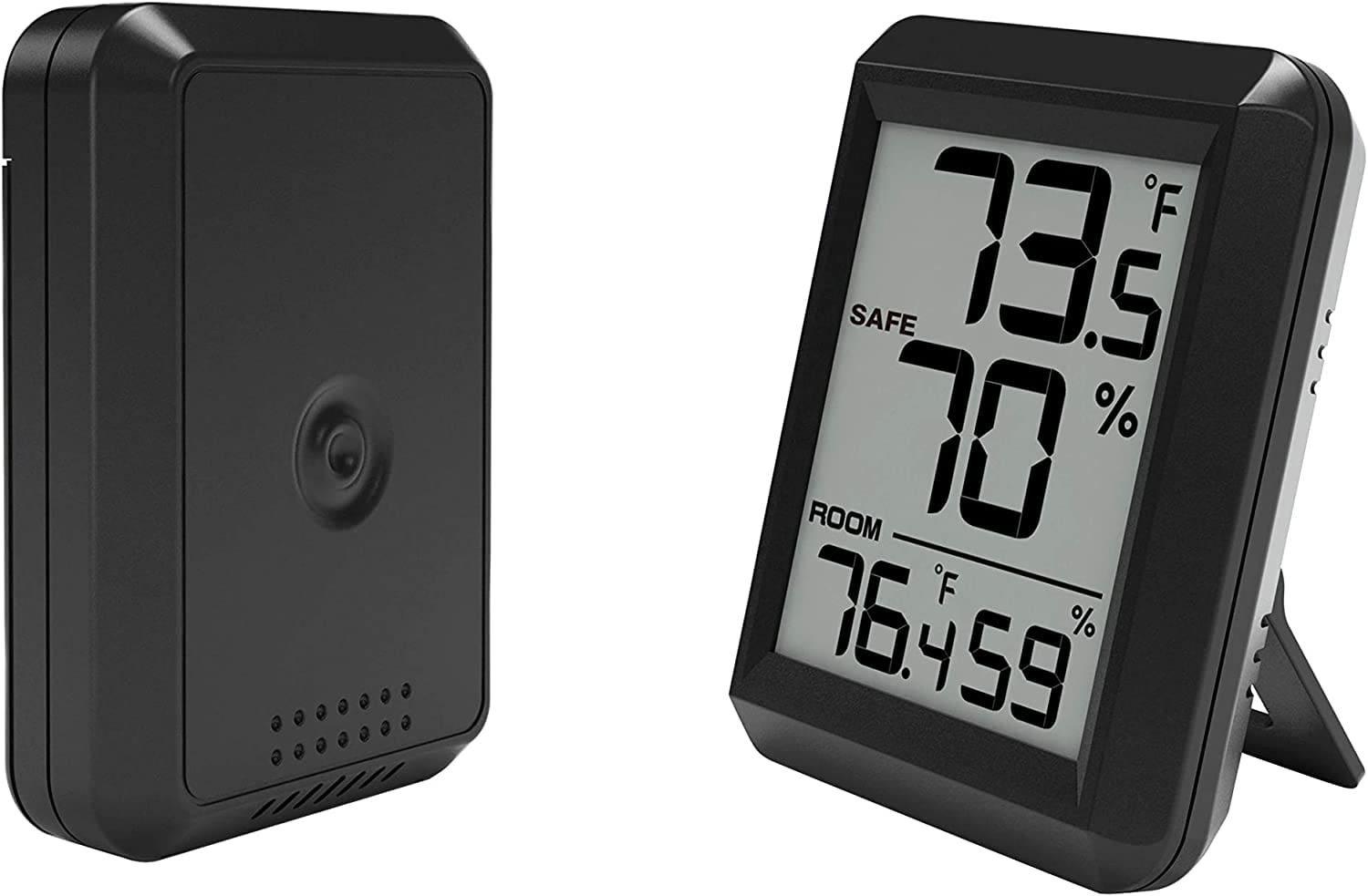

A power outlet for your gun safe is a great thing to have if you want to run A/C devices or lighting inside your gun safe.
Most kits come with everything you need to mount them and won’t break the bank price-wise.
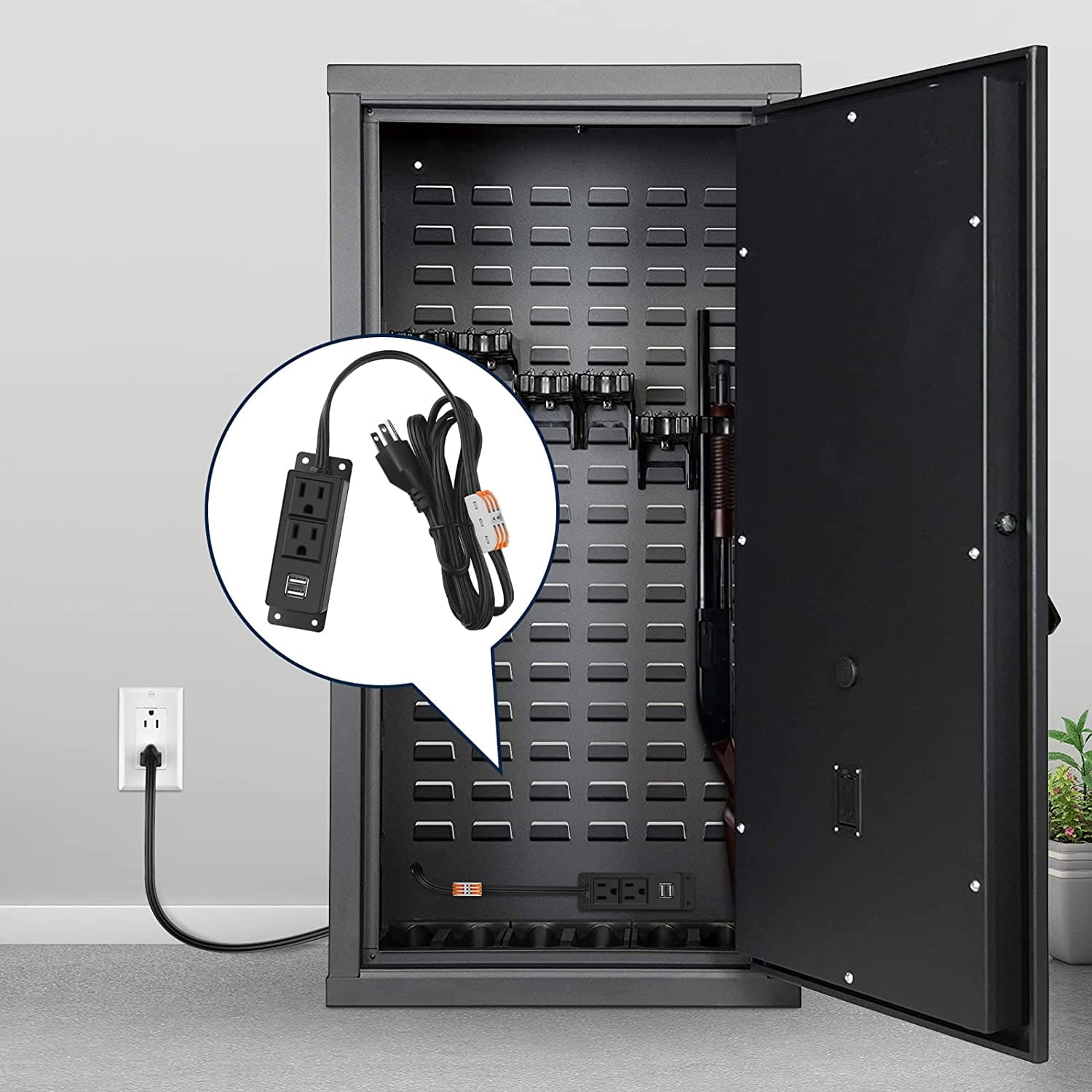

Accessories can also be found for the outside of your gun safe. SnapOn sells strong magnetic hooks that you stick to the side of the safe allowing you to hang a bugout bag, molle vests, or first aid kits.
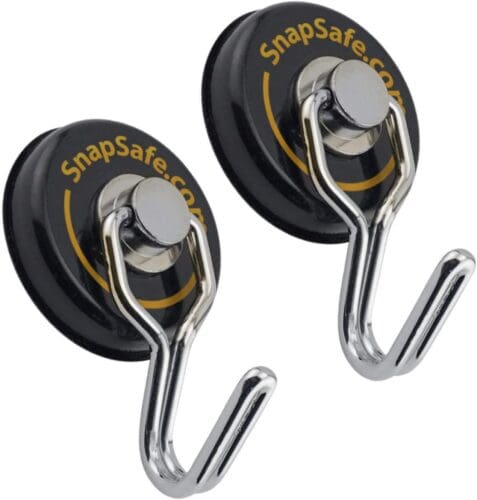

Each hook is capable of holding up to 65 lbs of weight! These things are great and very heavy-duty.
Dehumidifier bags are a cheap investment that’ll absorb any moisture inside of your gun safe and prevent rust and corrosion from ruining the finish on your firearms.
Hornady makes a very economical model that doesn’t take up too much space. There are other types of dehumidifiers on the market as well.


Be sure to choose a safe that is big enough to accommodate all of your accessories, as well as your firearms.
And don’t forget to bolt the safe down so that it can’t be easily stolen!
How Much Does a Gun Safe Weigh?
When shopping for a gun safe, you’ll want to consider the weight of the unit. The weight of a gun safe will vary greatly depending on the size and type of safe.
Below is a list of average weights for the different types of gun safes we discussed earlier.
Gun safe lockers for 3-5 rifles measure 11″ x 11.8″ x 54.33” on average and weigh between 50-80 lbs depending on metal thickness (usually between 14-16 gauge), accessories included, and build quality.
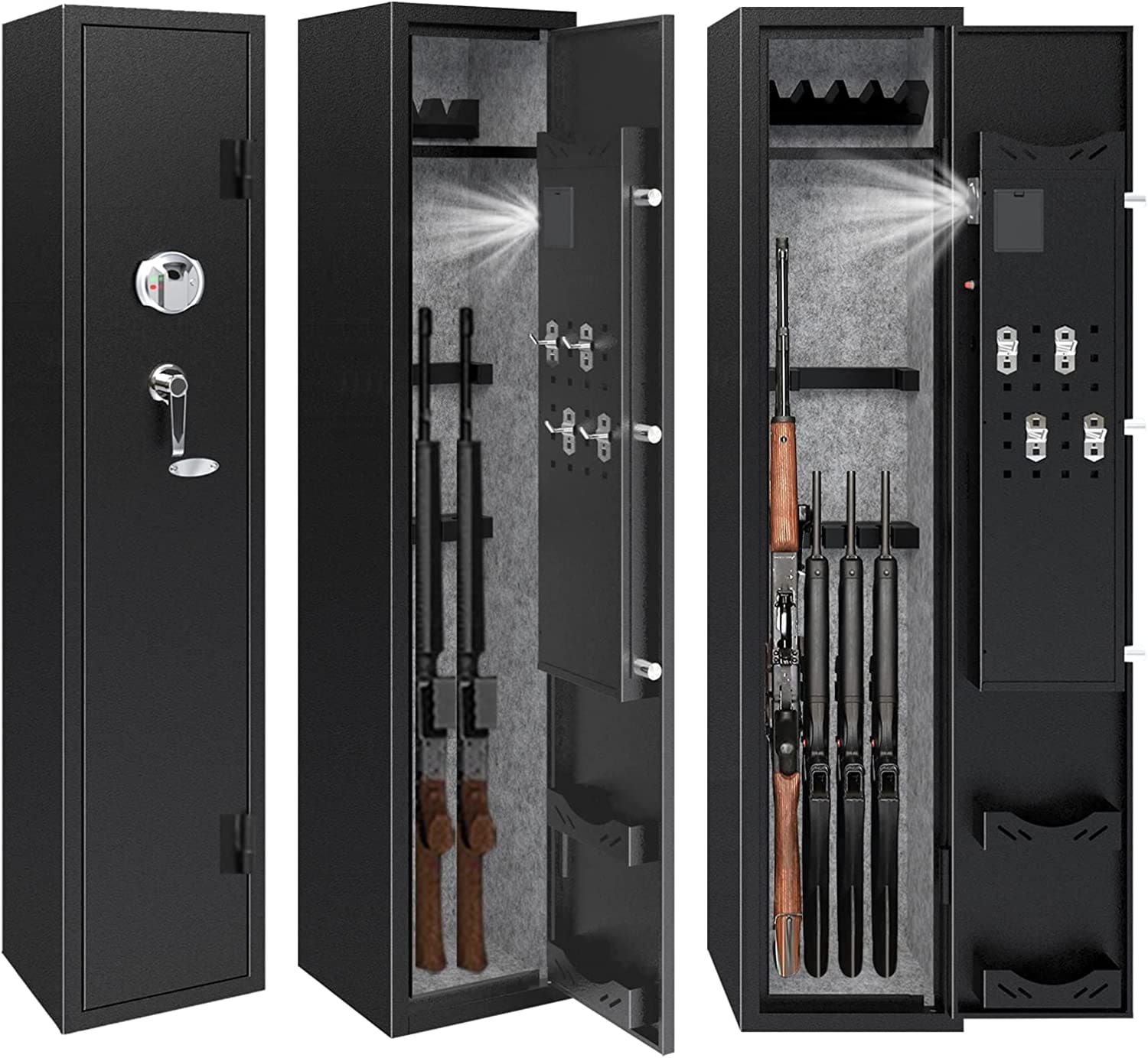

10-Gun Safes tend to weigh considerably more but this will change from model to model depending on their level of security features.
The SecureIt True gun safe below weighs just over 1,200 lbs! Due to its heavy gauge steel door and body as well as its concrete-filled walls, this safe is heavier than most 10-gun safes of the same size.
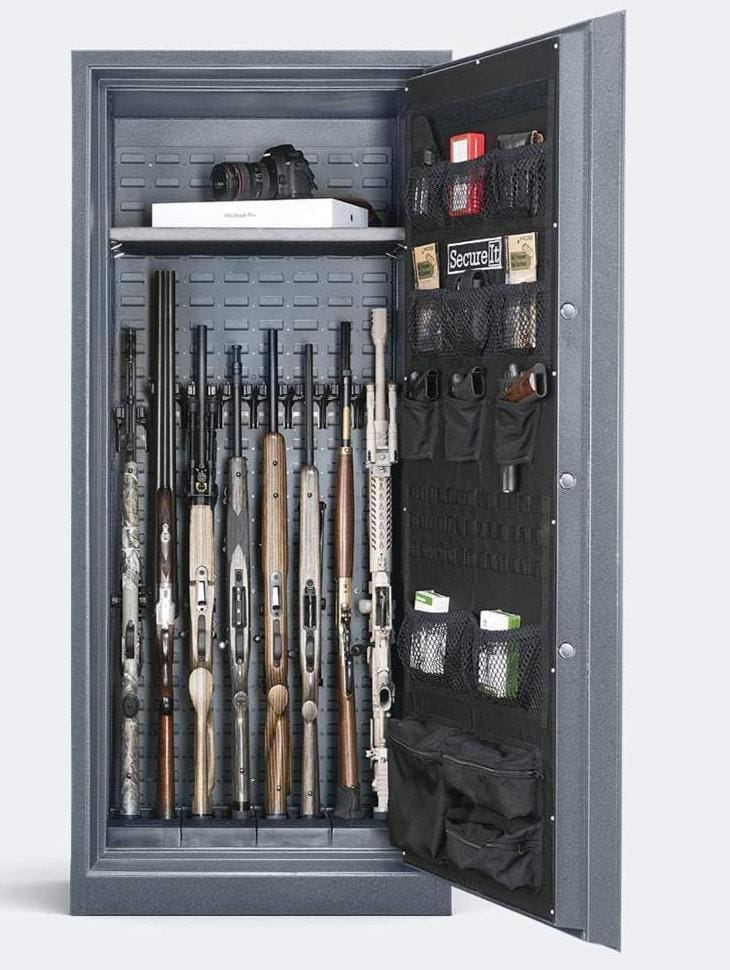

The 10-gun Union safe sold by Harbor Freight below only weighs 179 lbs in comparison!
So that should give you a little idea of just how much guns safes of similar sizes can differ drastically in weight as well as price.
The Union safe is only $380 bucks compared to the $4,200 price tag of the SecureIt True Safe!
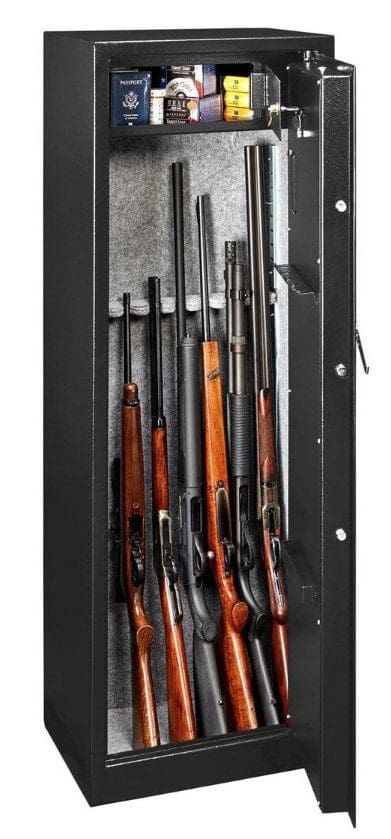

24-Gun Safes, just like the examples above, will vary considerably depending upon the safe factors stated above.
As an example, below is another Union safe from Harbor Freight that is also fire-rated up to 1,400 degrees but doesn’t give any official time rating.


Most likely, it’s using a sheet or two of drywall as the firewall and will probably last roughly 30 minutes in a house fire, if I had to guess.
This safe was built using 13 gauge steel sheets bringing the total weight up to only 372 lbs, but it’s still a pretty good value for those on a budget if you want something more secure than a metal gun cabinet like those shown above.
The rest of the really large, high-capacity gun safes out there only get heavier and heavier depending on their build quality and the materials used.
You can expect some of these safes to weigh well over 2,000 lbs and up!
How Do You Move a Gun Safe?
Moving a gun safe can be a daunting task but with the right tools and some help, it can be done.
Here are the steps you need to take:
- Disassemble the safe. This will make it easier to move.
- Get help from someone strong enough to lift the safe.
- Move the safe to its new location.
- Reassemble the safe.
Here are a few tips to help you move your gun safe:
- Make sure that you have enough help. Moving a gun safe is not a one-person job. You’ll need at least two people to move it safely.
- Use dollies or furniture pads to move the safe. Never try to lift the safe with your hands alone – it’s too heavy and can cause injury.
- If possible, empty the safe of all contents before moving it. This will make it lighter and easier to move around.
- Be careful when moving the safe around tight corners or through doorways. Try to go slowly and use caution so you don’t damage the safe or yourself.
Can You Move a Gun Safe With a Dolly?
When it comes to moving a gun safe, ensuring the safe transportation of this heavy and valuable item is of utmost importance.
A gun safe, with its sturdy construction and dense weight, requires careful planning and execution to prevent any damage or accidents.
One of the most recommended methods for moving a gun safe is by using a dolly or furniture slider.
These tools provide the necessary support and stability while minimizing the strain on your back and muscles.
When using a dolly, make sure it is sturdy and equipped with straps or fasteners to secure the safe in place (this will prevent any shifting or sliding during transit).
If a dolly or furniture slider is not available, there are alternative options to consider. Ropes or straps can be used to tie the gun safe securely to a piece of furniture, such as a sturdy table or couch.
It is crucial to ensure that the furniture can handle the weight and provide a stable base for the safe. Additionally, make sure to secure the ropes or straps tightly to prevent any movement.
Regardless of the method chosen, it’s always a good idea to enlist the help of people you trust when moving a gun safe.
The weight and bulkiness of a gun safe make it challenging for a single person to maneuver safely.
Before attempting to move the gun safe, it is wise to measure the doorways, hallways, and stairwells to ensure the safe will fit through all the necessary passages without causing any damage.
Pro Tip: If needed, remove any obstacles or furniture that may impede the safe’s path.
Always prioritize safety during the moving process. Use proper lifting techniques such as bending your knees and lifting with your legs to prevent back injuries.
Pro Tip: Take breaks when needed and listen to your body to avoid overexertion.
By following these guidelines and seeking assistance when needed, you can transport your gun safe securely while avoiding some common pitfalls.
Can You Move a Gun Safe With a Pallet Jack?
Moving a gun safe can be an overwhelming task that will require some careful planning and execution.
However, with the assistance of the right tools and techniques, such as a durable pallet jack, the process can be made significantly easier and more manageable.
Larger gun safes can weigh anywhere from 100 to 500 pounds and up, so you will need some help moving them.
First and foremost, ensure that you have taken all necessary safety precautions, like clearing the path of any obstacles to create a clear route from the current location of the gun safe to its intended destination.
Next, assess the weight and dimensions of the gun safe. Pallet jacks come in various weight capacities, so make sure you have one that can handle the size and weight of your specific safe.
Note: It is crucial to ensure that the pallet jack is in good working condition and that its wheels are properly lubricated for smooth movement.
To begin the actual moving process, position the pallet jack near the gun safe and carefully slide the forks of the pallet jack underneath the base of the safe, making sure that they are evenly positioned to prevent any imbalance or instability.
Once the forks are securely in place, engage the pallet jack’s hydraulic system to lift the gun safe off the ground (make sure you take things slow and steady to maintain control and prevent any sudden shifts or tilting).
With the gun safe lifted, carefully begin moving it toward its destination, using slow and deliberate movements while keeping an eye out for any potential obstacles or uneven surfaces.
If you encounter any tight spaces or corners along the way, take your time and maneuver the gun safe with extra caution.
Pro Tip: It may be necessary to have an additional person assist you in guiding the safe through tight turns or navigating narrow hallways.
Once you have safely transported the gun safe to its new location, slowly lower it down using the pallet jack’s hydraulic system.
Ensure that the safe is placed on a secure and level surface, taking care to avoid any potential damage to the floor or surroundings.
Finally, remember to take breaks as needed during the moving process. Moving a gun safe can be physically demanding, so it’s important to avoid overexertion and fatigue.
Always remember to stay hydrated and enlist the help of others if necessary!
How Much Does It Cost To Move A Heavy Gun Safe?
Depending on the size and weight of the safe, as well as the distance of the move, rates for professional movers generally start at $100 per hour.
The number of people involved in the move can also impact the cost and ease of the process.
While it is possible to move a gun safe with just a couple of strong individuals, having a dedicated team of movers can make the task much safer and more efficient.
When hiring a professional moving service, several factors need to be taken into consideration:
- The larger and heavier the safe, the more challenging the move will be. It is crucial to have a team of skilled movers who are experienced in handling such heavy and bulky items.
- Another important factor to consider is the distance of the move. If you are planning a local move within the same city or town, the logistics may be relatively straightforward.
- However, if you are moving to a different state or even across the country, additional preparations and coordination will be required.
- Long-distance moves often involve more complex logistics, including transportation arrangements and potentially obtaining permits or complying with specific regulations.
Any experts you hire should help guide you through the entire process, from assessing the safest route for transport to installing the safe in its new location.
How Do You Secure a Gun Safe in Your Home?
When it comes to gun safes, there are a few things you need to keep in mind in order to ensure your safe is as secure as possible.
One crucial aspect to consider is the importance of bolting down these safes. By firmly anchoring a gun safe to the floor or wall, you significantly enhance its protective capabilities.
The primary advantage of bolting down a gun safe is the prevention of unauthorized access. A securely fastened safe makes it difficult for burglars to easily remove or manipulate the safe itself.
This acts as a strong deterrent against theft, as potential intruders are less likely to attempt stealing a bolted-down safe due to the additional time and effort required.
Apart from safeguarding against theft, bolting down a gun safe also enhances overall stability. Firearms can be heavy, and by securely attaching the safe to a solid surface, you minimize the risk of it tipping over accidentally.
This is particularly crucial if you have curious children or pets in your home, as it prevents any potential accidents or injuries.
When considering the placement of a gun safe, it’s essential to choose a strategic location that allows easy access for authorized individuals while maintaining discretion.
Bolting down the safe in a discreet spot further reinforces its security, as it becomes inconspicuous to potential thieves or intruders.
What Do You Put Under a Gun Safe?
When it comes to what you can under a gun safe, there are a few options you can consider. One popular choice is to place a piece of plywood or a thick rubber mat on the floor and then position the gun safe on top of it.
This provides a stable and level base for the safe, ensuring that it remains secure and balanced.
Another option is to use a concrete anchor kit to secure the gun safe directly to the floor. This provides an additional layer of security, making it extremely difficult for any potential thieves to remove or tamper with the safe.
Others use a moisture barrier such as plastic or even asphalt roofing paper (and some choose to put nothing under the safe at all).
It’s worth noting that some gun safes come with built-in features like adjustable feet or other leveling mechanisms. These help keep your safe perfectly aligned and stable on any type of flooring surface.
Remember, the choice of what to put under your gun safe will depend on factors such as the type and weight of your safe, as well as the flooring material in your home.
Can a Gun Safe Sit on the Carpet?
Many people assume that a gun safe can sit on the carpet without any issues. However, this assumption can lead to potential problems and risks.
Let’s delve deeper into why placing a gun safe directly on the carpet may not be the wisest choice.
One of the main concerns is moisture. Carpets can hold moisture from spills, leaks, or high humidity levels in the environment.
Over time, this moisture can seep into the bottom of the gun safe, causing corrosion and damage to the firearms and other valuables inside.
Additionally, the moisture trapped under the safe can promote the growth of mold and mildew, which can further degrade the contents.
Another aspect to consider is stability. Placing a heavy object like a gun safe on a soft surface like a carpet may result in an unstable base.
This can increase the risk of the safe tipping over, especially if there is any movement or impact (uneven surfaces or thick carpets can exacerbate this issue, making the safe even more prone to toppling over).
Carpets can also interfere with the overall fire protection capabilities of the gun safe. Most safes provide insulation and fire-resistant materials to safeguard your firearms from extreme temperatures.
However, when placed directly on the carpet, the heat can transfer more readily to the safe through the additional layer of material.
As a result, this compromises the ability of the safe to maintain a safe internal temperature during a fire, potentially damaging the contents.
To address these concerns, it is recommended to use a sturdy, flat surface as a base for your gun safe.
- This can include concrete, tile, or specially designed safe anchors or installation systems.
- Alternatively, you can use a thick, non-combustible material such as a fire-resistant mat between the safe and the carpet to mitigate some of the risks associated with carpet placement
Can You Put a Gun Safe on Tile Floor?
Sure! Let’s dive deeper into the topic of placing a gun safe on tile flooring. Tile flooring is a highly versatile and commonly used option in many homes, known for its durability, aesthetic appeal, and easy maintenance.
It is particularly favored in areas prone to high foot traffic or areas where spills and accidents may occur, such as kitchens and bathrooms.
When it comes to placing a gun safe on tile flooring, there are a few considerations to keep in mind:
- The first factor to consider is the weight of the gun safe.
- Tile flooring can generally support heavy loads, but it’s essential to ensure that the flooring is properly installed, level, and secure.
- If the tile flooring is not installed correctly or is weakened over time, placing a heavy gun safe on it could potentially result in cracks or damage to the tiles.
Another aspect to consider is the type of gun safe you have. Gun safes come in various sizes, shapes, and designs, each with its own weight distribution characteristics.
Some gun safes are designed to be freestanding, while others are intended to be bolted or anchored to the floor.
If you have a gun safe that requires anchoring, it’s crucial to evaluate the tile flooring’s capabilities to support the weight and securely fasten the safe.
Additionally, the location of the gun safe within the space matters!
Placing a gun safe closer to load-bearing walls or in areas with additional floor support, such as near interior walls, can provide added stability compared to placing it in the center of a room.
Pro Tip: It’s advisable to consult with a professional contractor or a structural engineer to assess the specific conditions of your tile floor and determine its load-bearing capacity.
Lastly, it’s important to consider the potential impact on the tiles themselves.
While tile flooring is generally resilient, the concentrated weight of a gun safe could lead to point loading, potentially causing cracks or damage to the tiles.
Placing a protective layer, such as a rubber mat or a piece of plywood, under the gun safe can help distribute the weight more evenly and minimize the risk of tile damage.
Can You Put a Gun Safe Upstairs?
Some people assume that they cannot put a gun safe upstairs due to concerns about the weight and structural integrity of the floor.
However, it is important to note that this belief is unfounded and lacks a factual basis.
Firstly, let’s address the concern regarding the weight of a gun safe. While it is true that gun safes can be quite heavy, modern construction techniques and building codes are designed to accommodate the appropriate weight distribution throughout a residential structure.
Most floors are capable of supporting the weight of a typical gun safe without any issues. Also, property developers and engineers take into account the potential weight loads when planning and constructing homes, ensuring that the structure is sturdy enough to handle such loads.
There are several advantages to placing a gun safe upstairs:
- One of the primary benefits is enhanced security.
- Burglars typically target ground-level areas as they are easier to access.
- By placing your gun safe upstairs, you introduce an additional layer of protection, making it more challenging for unauthorized individuals to reach and tamper with your firearms.
- Storing your firearms in an upstairs gun safe can help keep them out of the reach of children or other household members who should not have access to them.



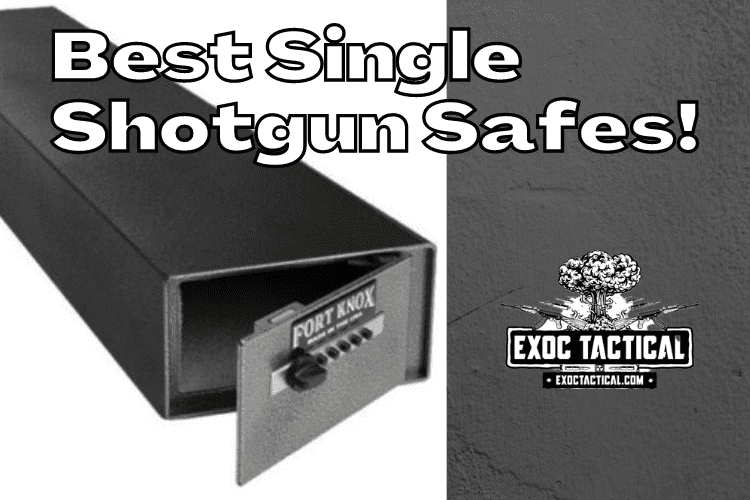
It’s helpful to learn that we’d consider how long a gun safe will last in a fire when choosing one. My wife and I decided to learn how to use a gun and get a license to keep one in our home in case of a break-in. That’s why we’re looking for a gun safe, and we believe your post will help us find it next week.